Honda Power Equipment HRB425C User Manual
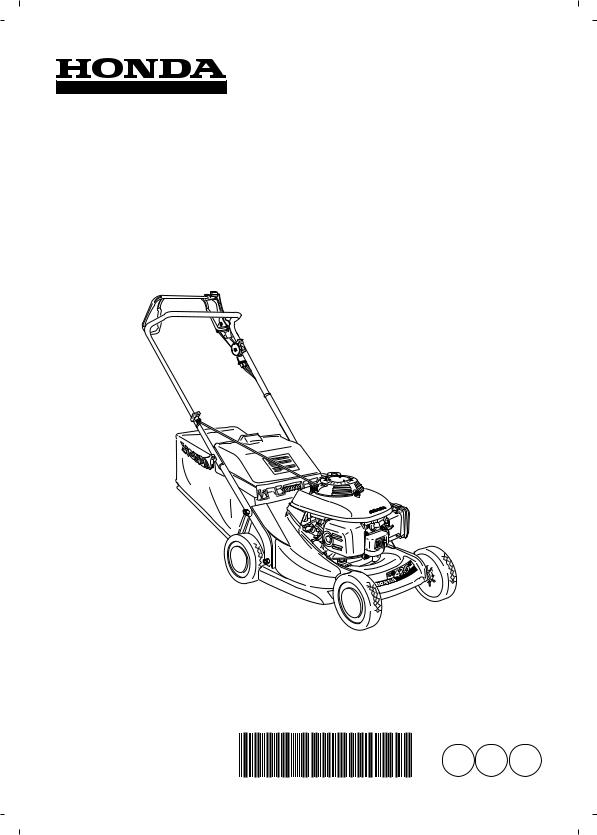
POWER EQUIPMENT
LAWN MOWER
TONDEUSE À GAZON
RASENMÄHER
HRB425C
OWNER’S MANUAL
MANUEL DE L’UTILISATEUR
BETRIEBSANLEITUNG
Honda Europe Power Equipment S.A. Pôle 45 - Rue des Châtaigniers 45140 ORMES - FRANCE
1 GB F D
* 00X37 VG8 F05*

INHALTSVERZEICHNIS |
D |
|
ZUR BEACHTUNG. . . . . . . . . . . . . . . . . . . . . . . . . . . . . . . . . . . . . . . . . . . . . . . . . . . . . . . 5 SICHERHEITSHINWEISE . . . . . . . . . . . . . . . . . . . . . . . . . . . . . . . . . . . . . . . . . . . . . . . . . 6
EINFÜHRUNG . . . . . . . . . . . . . . . . . . . . . . . . . . . . . . . . . . . . . . . . . . . . . . . . . . . . . . . . . 12
Erklärung der in dieser Bedienungsanleitung verwendeten Symbole. . . . . . . . . . . . . . . . 12
GRUNDLEGENDE ERKLÄRUNGEN . . . . . . . . . . . . . . . . . . . . . . . . . . . . . . . . . . . . . . . 14
Bezeichnung der Bauteile . . . . . . . . . . . . . . . . . . . . . . . . . . . . . . . . . . . . . . . . . . . . . . . . . 14 Beschreibung der Sicherheitshinweise . . . . . . . . . . . . . . . . . . . . . . . . . . . . . . . . . . . . . . . 16 Erklärung der in dieser Bedienungsanleitung verwendeten Symbole. . . . . . . . . . . . . . . . 16 Typenschild der Machine . . . . . . . . . . . . . . . . . . . . . . . . . . . . . . . . . . . . . . . . . . . . . . . . . 16
VORBEITUNGEN UND KONTROLLEN VOR INBETRIEBNAHME . . . . . . . . . . . . . . . . 18
Kontrolle des Kraftstoffstandes . . . . . . . . . . . . . . . . . . . . . . . . . . . . . . . . . . . . . . . . . . . . . 18 Alkoholhaltiges Benzin . . . . . . . . . . . . . . . . . . . . . . . . . . . . . . . . . . . . . . . . . . . . . . . . . . . 20 Kontrolle des Luftfilters . . . . . . . . . . . . . . . . . . . . . . . . . . . . . . . . . . . . . . . . . . . . . . . . . . . 20 Kontrolle des Messers. . . . . . . . . . . . . . . . . . . . . . . . . . . . . . . . . . . . . . . . . . . . . . . . . . . . 22 Schnitthöheneinstellung . . . . . . . . . . . . . . . . . . . . . . . . . . . . . . . . . . . . . . . . . . . . . . . . . . 24 Ölstandkontrolle . . . . . . . . . . . . . . . . . . . . . . . . . . . . . . . . . . . . . . . . . . . . . . . . . . . . . . . . 26 Kontrolle des Grassacks . . . . . . . . . . . . . . . . . . . . . . . . . . . . . . . . . . . . . . . . . . . . . . . . . . 28
ANLASSEN UND ABSCHALTEN DES MOTORS . . . . . . . . . . . . . . . . . . . . . . . . . . . . . 30
Starten des Motors . . . . . . . . . . . . . . . . . . . . . . . . . . . . . . . . . . . . . . . . . . . . . . . . . . . . . . 30 Betrieb in höhenlagen . . . . . . . . . . . . . . . . . . . . . . . . . . . . . . . . . . . . . . . . . . . . . . . . . . . . 32 Abstellen des Motors. . . . . . . . . . . . . . . . . . . . . . . . . . . . . . . . . . . . . . . . . . . . . . . . . . . . . 34 “Überfetteter” Motor. . . . . . . . . . . . . . . . . . . . . . . . . . . . . . . . . . . . . . . . . . . . . . . . . . . . . . 34
EMPFEHLUNGEN FÜR DEN BETRIEB . . . . . . . . . . . . . . . . . . . . . . . . . . . . . . . . . . . . . 36
Mähvorgang . . . . . . . . . . . . . . . . . . . . . . . . . . . . . . . . . . . . . . . . . . . . . . . . . . . . . . . . . . . 36 Ausleeren des Grasfangsacks . . . . . . . . . . . . . . . . . . . . . . . . . . . . . . . . . . . . . . . . . . . . . 42
WARTUNGSHINWEISE . . . . . . . . . . . . . . . . . . . . . . . . . . . . . . . . . . . . . . . . . . . . . . . . . . 44
Wartung des Luftfilters . . . . . . . . . . . . . . . . . . . . . . . . . . . . . . . . . . . . . . . . . . . . . . . . . . . 44 Motorölwechsel . . . . . . . . . . . . . . . . . . . . . . . . . . . . . . . . . . . . . . . . . . . . . . . . . . . . . . . . . 46 Zündkerzenwechsel . . . . . . . . . . . . . . . . . . . . . . . . . . . . . . . . . . . . . . . . . . . . . . . . . . . . . 48 Wartung des Funkenfänger (Sonderzubehör). . . . . . . . . . . . . . . . . . . . . . . . . . . . . . . . . . 50 Nachstellen des Gaszugs . . . . . . . . . . . . . . . . . . . . . . . . . . . . . . . . . . . . . . . . . . . . . . . . . 52 Vergasereinstellung . . . . . . . . . . . . . . . . . . . . . . . . . . . . . . . . . . . . . . . . . . . . . . . . . . . . . 54 Einstellung des Messerkupplungsspiels . . . . . . . . . . . . . . . . . . . . . . . . . . . . . . . . . . . . . 54 Überprüfung der Schwungradbremse . . . . . . . . . . . . . . . . . . . . . . . . . . . . . . . . . . . . . . . . 56 Einstellung des Spiels vom Bedienhebel des Messerstops . . . . . . . . . . . . . . . . . . . . . . . 58 Einstellen des Fahrkupplungsspiels (Modell mit Radantrieb) . . . . . . . . . . . . . . . . . . . . . . 58 Auswechseln des Messers . . . . . . . . . . . . . . . . . . . . . . . . . . . . . . . . . . . . . . . . . . . . . . . . 60 Grasfangsack: Pflege und Erneuerung . . . . . . . . . . . . . . . . . . . . . . . . . . . . . . . . . . . . . . . 64 Überprüfung des Antriebriemens . . . . . . . . . . . . . . . . . . . . . . . . . . . . . . . . . . . . . . . . . . . 66 Einstellung des Riemenantriebs . . . . . . . . . . . . . . . . . . . . . . . . . . . . . . . . . . . . . . . . . . . . 68 Antriebskette . . . . . . . . . . . . . . . . . . . . . . . . . . . . . . . . . . . . . . . . . . . . . . . . . . . . . . . . . . . 68 Wartungsplan . . . . . . . . . . . . . . . . . . . . . . . . . . . . . . . . . . . . . . . . . . . . . . . . . . . . . . . . . . 70
STÖRUNGSBESEITIGUNG. . . . . . . . . . . . . . . . . . . . . . . . . . . . . . . . . . . . . . . . . . . . . . . 73
GERÄTETRANSPORT. . . . . . . . . . . . . . . . . . . . . . . . . . . . . . . . . . . . . . . . . . . . . . . . . . . 76
Transport des Rasenmähers. . . . . . . . . . . . . . . . . . . . . . . . . . . . . . . . . . . . . . . . . . . . . . . 76 Einladen des Rasenmähers . . . . . . . . . . . . . . . . . . . . . . . . . . . . . . . . . . . . . . . . . . . . . . . 76
LÄNGERE AUßERBETRIEBSETZUNG . . . . . . . . . . . . . . . . . . . . . . . . . . . . . . . . . . . . . 78
Längere Außerbetriebsetzung (Überwinterung) . . . . . . . . . . . . . . . . . . . . . . . . . . . . . . . . 78 Wiederinbetriebnahme nach der Einlagerung. . . . . . . . . . . . . . . . . . . . . . . . . . . . . . . . . . 80
TECHNISCHE DATEN . . . . . . . . . . . . . . . . . . . . . . . . . . . . . . . . . . . . . . . . . . . . . . . . . . . 82
2

GB |
CONTENTS |
|
NOTE . . . . . . . . . . . . . . . . . . . . . . . . . . . . . . . . . . . . . . . . . . . . . . . . . . . . . . . . . . . . . . . . . 5 SAFETY INSTRUCTIONS . . . . . . . . . . . . . . . . . . . . . . . . . . . . . . . . . . . . . . . . . . . . . . . . . 8
INTRODUCTION . . . . . . . . . . . . . . . . . . . . . . . . . . . . . . . . . . . . . . . . . . . . . . . . . . . . . . . 13
Description of the codes used in this manual . . . . . . . . . . . . . . . . . . . . . . . . . . . . . . . . . . 13
GENERAL DESCRIPTION. . . . . . . . . . . . . . . . . . . . . . . . . . . . . . . . . . . . . . . . . . . . . . . . 15
Equipment identification . . . . . . . . . . . . . . . . . . . . . . . . . . . . . . . . . . . . . . . . . . . . . . . . . . 15 Safety label locations . . . . . . . . . . . . . . . . . . . . . . . . . . . . . . . . . . . . . . . . . . . . . . . . . . . . 17 Description of the symbols used in this manual . . . . . . . . . . . . . . . . . . . . . . . . . . . . . . . . 17 Identification of the machine . . . . . . . . . . . . . . . . . . . . . . . . . . . . . . . . . . . . . . . . . . . . . . . 17
PREPARATIONS AND CHECKS BEFORE USE . . . . . . . . . . . . . . . . . . . . . . . . . . . . . . 19
Checking fuel level . . . . . . . . . . . . . . . . . . . . . . . . . . . . . . . . . . . . . . . . . . . . . . . . . . . . . . 19 Fuel containing alcohol . . . . . . . . . . . . . . . . . . . . . . . . . . . . . . . . . . . . . . . . . . . . . . . . . . . 21 Checking the air cleaner . . . . . . . . . . . . . . . . . . . . . . . . . . . . . . . . . . . . . . . . . . . . . . . . . . 21 Checking blade condition . . . . . . . . . . . . . . . . . . . . . . . . . . . . . . . . . . . . . . . . . . . . . . . . . 23 Adjusting cutting height . . . . . . . . . . . . . . . . . . . . . . . . . . . . . . . . . . . . . . . . . . . . . . . . . . . 25 Checking engine oil level . . . . . . . . . . . . . . . . . . . . . . . . . . . . . . . . . . . . . . . . . . . . . . . . . 27 Checking the grass bag . . . . . . . . . . . . . . . . . . . . . . . . . . . . . . . . . . . . . . . . . . . . . . . . . . 29
STARTING AND STOPPING THE ENGINE . . . . . . . . . . . . . . . . . . . . . . . . . . . . . . . . . . 31
Starting the engine . . . . . . . . . . . . . . . . . . . . . . . . . . . . . . . . . . . . . . . . . . . . . . . . . . . . . . 31 Using the mower at high altitudes . . . . . . . . . . . . . . . . . . . . . . . . . . . . . . . . . . . . . . . . . . . 33
Stopping the engine . . . . . . . . . . . . . . . . . . . . . . . . . . . . . . . . . . . . . . . . . . . . . . . . . . . . . 35 Flooded engine . . . . . . . . . . . . . . . . . . . . . . . . . . . . . . . . . . . . . . . . . . . . . . . . . . . . . . . . . 35
OPERATING HINTS AND TIPS . . . . . . . . . . . . . . . . . . . . . . . . . . . . . . . . . . . . . . . . . . . . 37
Mowing procedure. . . . . . . . . . . . . . . . . . . . . . . . . . . . . . . . . . . . . . . . . . . . . . . . . . . . . . . 37 Emptying the grass bag . . . . . . . . . . . . . . . . . . . . . . . . . . . . . . . . . . . . . . . . . . . . . . . . . . 43
MAINTENANCE . . . . . . . . . . . . . . . . . . . . . . . . . . . . . . . . . . . . . . . . . . . . . . . . . . . . . . . . 45
Air cleaner maintenance . . . . . . . . . . . . . . . . . . . . . . . . . . . . . . . . . . . . . . . . . . . . . . . . . . 45 Changing the engine oil . . . . . . . . . . . . . . . . . . . . . . . . . . . . . . . . . . . . . . . . . . . . . . . . . . 47 Spark plug . . . . . . . . . . . . . . . . . . . . . . . . . . . . . . . . . . . . . . . . . . . . . . . . . . . . . . . . . . . . . 49 Spark arrester maintenance (optional part). . . . . . . . . . . . . . . . . . . . . . . . . . . . . . . . . . . . 51 Throttle control cable adjustment . . . . . . . . . . . . . . . . . . . . . . . . . . . . . . . . . . . . . . . . . . . 53 Carburetor adjustment . . . . . . . . . . . . . . . . . . . . . . . . . . . . . . . . . . . . . . . . . . . . . . . . . . . 55 Blade clutch lever free play . . . . . . . . . . . . . . . . . . . . . . . . . . . . . . . . . . . . . . . . . . . . . . . . 55 Flywheel brake inspection. . . . . . . . . . . . . . . . . . . . . . . . . . . . . . . . . . . . . . . . . . . . . . . . . 57 Blade brake cable adjustment. . . . . . . . . . . . . . . . . . . . . . . . . . . . . . . . . . . . . . . . . . . . . . 59 Clutch cable adjustment (self-propelled models only). . . . . . . . . . . . . . . . . . . . . . . . . . . . 59 Blade fitting and removal. . . . . . . . . . . . . . . . . . . . . . . . . . . . . . . . . . . . . . . . . . . . . . . . . . 61 Grass bag cleaning and replacement . . . . . . . . . . . . . . . . . . . . . . . . . . . . . . . . . . . . . . . . 65 Forward drive belt check . . . . . . . . . . . . . . . . . . . . . . . . . . . . . . . . . . . . . . . . . . . . . . . . . . 67 Belt tension adjustment. . . . . . . . . . . . . . . . . . . . . . . . . . . . . . . . . . . . . . . . . . . . . . . . . . . 69 Final transmission chain . . . . . . . . . . . . . . . . . . . . . . . . . . . . . . . . . . . . . . . . . . . . . . . . . . 69 Maintenance schedule . . . . . . . . . . . . . . . . . . . . . . . . . . . . . . . . . . . . . . . . . . . . . . . . . . . 71
TROUBLESHOOTING . . . . . . . . . . . . . . . . . . . . . . . . . . . . . . . . . . . . . . . . . . . . . . . . . . . 74
TRANSPORT . . . . . . . . . . . . . . . . . . . . . . . . . . . . . . . . . . . . . . . . . . . . . . . . . . . . . . . . . . 77
Transporting the mower . . . . . . . . . . . . . . . . . . . . . . . . . . . . . . . . . . . . . . . . . . . . . . . . . . 77 Loading the mower . . . . . . . . . . . . . . . . . . . . . . . . . . . . . . . . . . . . . . . . . . . . . . . . . . . . . . 77
STORAGE . . . . . . . . . . . . . . . . . . . . . . . . . . . . . . . . . . . . . . . . . . . . . . . . . . . . . . . . . . . . 79
Preparations for storing the mower . . . . . . . . . . . . . . . . . . . . . . . . . . . . . . . . . . . . . . . . . . 79 Using the mower after a storage period . . . . . . . . . . . . . . . . . . . . . . . . . . . . . . . . . . . . . . 81
TECHNICAL SPECIFICATIONS . . . . . . . . . . . . . . . . . . . . . . . . . . . . . . . . . . . . . . . . . . . 83
3

TABLE DES MATIÈRES |
F |
|
NOTE . . . . . . . . . . . . . . . . . . . . . . . . . . . . . . . . . . . . . . . . . . . . . . . . . . . . . . . . . . . . . . . . . 5 CONSIGNES DE SÉCURITÉ . . . . . . . . . . . . . . . . . . . . . . . . . . . . . . . . . . . . . . . . . . . . . . 10
INTRODUCTION . . . . . . . . . . . . . . . . . . . . . . . . . . . . . . . . . . . . . . . . . . . . . . . . . . . . . . . 13
Explication des codes utilisés dans ce manuel . . . . . . . . . . . . . . . . . . . . . . . . . . . . . . . . . 13
DESCRIPTION GÉNÉRALE . . . . . . . . . . . . . . . . . . . . . . . . . . . . . . . . . . . . . . . . . . . . . . 15
Identification des éléments . . . . . . . . . . . . . . . . . . . . . . . . . . . . . . . . . . . . . . . . . . . . . . . . 15 Emplacement des étiquettes de sécurité . . . . . . . . . . . . . . . . . . . . . . . . . . . . . . . . . . . . . 17 Explication des symboles utilisés dans le manuel . . . . . . . . . . . . . . . . . . . . . . . . . . . . . . 17 Identification de la machine. . . . . . . . . . . . . . . . . . . . . . . . . . . . . . . . . . . . . . . . . . . . . . . . 17
PRÉPARATIONS ET VÉRIFICATIONS AVANT UTILISATION . . . . . . . . . . . . . . . . . . . 19
Vérification du niveau d’essence. . . . . . . . . . . . . . . . . . . . . . . . . . . . . . . . . . . . . . . . . . . . 19 Essence contenant de l’alcool. . . . . . . . . . . . . . . . . . . . . . . . . . . . . . . . . . . . . . . . . . . . . . 21 Vérification du filtre à air . . . . . . . . . . . . . . . . . . . . . . . . . . . . . . . . . . . . . . . . . . . . . . . . . . 21 Vérification de l’état de la lame . . . . . . . . . . . . . . . . . . . . . . . . . . . . . . . . . . . . . . . . . . . . . 23 Réglage de la hauteur de coupe . . . . . . . . . . . . . . . . . . . . . . . . . . . . . . . . . . . . . . . . . . . . 25 Vérification du niveau de l’huile moteur . . . . . . . . . . . . . . . . . . . . . . . . . . . . . . . . . . . . . . 27 Vérification du sac de ramassage . . . . . . . . . . . . . . . . . . . . . . . . . . . . . . . . . . . . . . . . . . . 29
MISE EN MARCHE ET ARRÊT DU MOTEUR. . . . . . . . . . . . . . . . . . . . . . . . . . . . . . . . . 31
Mise en marche du moteur . . . . . . . . . . . . . . . . . . . . . . . . . . . . . . . . . . . . . . . . . . . . . . . . 31 Fonctionnement en haute altitude. . . . . . . . . . . . . . . . . . . . . . . . . . . . . . . . . . . . . . . . . . . 33 Arrêt du moteur . . . . . . . . . . . . . . . . . . . . . . . . . . . . . . . . . . . . . . . . . . . . . . . . . . . . . . . . . 35 Moteur noyé . . . . . . . . . . . . . . . . . . . . . . . . . . . . . . . . . . . . . . . . . . . . . . . . . . . . . . . . . . . 35
CONSEILS D’UTILISATION . . . . . . . . . . . . . . . . . . . . . . . . . . . . . . . . . . . . . . . . . . . . . . 37
Procédure de tonte . . . . . . . . . . . . . . . . . . . . . . . . . . . . . . . . . . . . . . . . . . . . . . . . . . . . . . 37 Vidage du sac de ramassage . . . . . . . . . . . . . . . . . . . . . . . . . . . . . . . . . . . . . . . . . . . . . . 43
ENTRETIEN . . . . . . . . . . . . . . . . . . . . . . . . . . . . . . . . . . . . . . . . . . . . . . . . . . . . . . . . . . . 45
Entretien du filtre à air . . . . . . . . . . . . . . . . . . . . . . . . . . . . . . . . . . . . . . . . . . . . . . . . . . . . 45 Changement de l’huile moteur . . . . . . . . . . . . . . . . . . . . . . . . . . . . . . . . . . . . . . . . . . . . . 47 Bougie d’allumage. . . . . . . . . . . . . . . . . . . . . . . . . . . . . . . . . . . . . . . . . . . . . . . . . . . . . . . 49 Entretien du pare-étincelles (pièce en option). . . . . . . . . . . . . . . . . . . . . . . . . . . . . . . . . . 51 Réglage du câble de commande des gaz. . . . . . . . . . . . . . . . . . . . . . . . . . . . . . . . . . . . . 53 Réglage du carburateur . . . . . . . . . . . . . . . . . . . . . . . . . . . . . . . . . . . . . . . . . . . . . . . . . . 55 Jeu au levier d’embrayage de lame . . . . . . . . . . . . . . . . . . . . . . . . . . . . . . . . . . . . . . . . . 55 Contrôle du frein de volant moteur . . . . . . . . . . . . . . . . . . . . . . . . . . . . . . . . . . . . . . . . . . 57 Réglage du câble de frein de lame . . . . . . . . . . . . . . . . . . . . . . . . . . . . . . . . . . . . . . . . . . 59 Réglage du câble d’embrayage d’avancement (modèles auto-propulsés seulement) . . . 59 Montage et démontage de lame . . . . . . . . . . . . . . . . . . . . . . . . . . . . . . . . . . . . . . . . . . . . 61 Nettoyage et changement du sac de ramassage . . . . . . . . . . . . . . . . . . . . . . . . . . . . . . . 65 Vérification de la courroie d’avancement . . . . . . . . . . . . . . . . . . . . . . . . . . . . . . . . . . . . . 67 Réglage de la tension de la courroie. . . . . . . . . . . . . . . . . . . . . . . . . . . . . . . . . . . . . . . . . 69 Chaine de transmission. . . . . . . . . . . . . . . . . . . . . . . . . . . . . . . . . . . . . . . . . . . . . . . . . . . 69 Calendrier d’entretien . . . . . . . . . . . . . . . . . . . . . . . . . . . . . . . . . . . . . . . . . . . . . . . . . . . . 72
DÉPISTAGE DES PANNES. . . . . . . . . . . . . . . . . . . . . . . . . . . . . . . . . . . . . . . . . . . . . . . 75
TRANSPORT . . . . . . . . . . . . . . . . . . . . . . . . . . . . . . . . . . . . . . . . . . . . . . . . . . . . . . . . . . 77
Transport de la tondeuse . . . . . . . . . . . . . . . . . . . . . . . . . . . . . . . . . . . . . . . . . . . . . . . . . 77 Chargement de la tondeuse . . . . . . . . . . . . . . . . . . . . . . . . . . . . . . . . . . . . . . . . . . . . . . . 77
REMISAGE. . . . . . . . . . . . . . . . . . . . . . . . . . . . . . . . . . . . . . . . . . . . . . . . . . . . . . . . . . . . 79
Préparation pour le remisage . . . . . . . . . . . . . . . . . . . . . . . . . . . . . . . . . . . . . . . . . . . . . . 79 Réutilisation après remisage. . . . . . . . . . . . . . . . . . . . . . . . . . . . . . . . . . . . . . . . . . . . . . . 81
SPÉCIFICATIONS TECHNIQUES . . . . . . . . . . . . . . . . . . . . . . . . . . . . . . . . . . . . . . . . . . 84
4

D ZUR BEACHTUNG / GB NOTE / F NOTE
. . . . . . . . . . . . . . . . . . . . . . . . . . . . . . . . . . . . . . . . . . . . . . . . . . . . . . . . . . . . . . . . . . . . . . . . . . . . . . . . . . .
. . . . . . . . . . . . . . . . . . . . . . . . . . . . . . . . . . . . . . . . . . . . . . . . . . . . . . . . . . . . . . . . . . . . . . . . . . . . . . . . . . .
. . . . . . . . . . . . . . . . . . . . . . . . . . . . . . . . . . . . . . . . . . . . . . . . . . . . . . . . . . . . . . . . . . . . . . . . . . . . . . . . . . .
. . . . . . . . . . . . . . . . . . . . . . . . . . . . . . . . . . . . . . . . . . . . . . . . . . . . . . . . . . . . . . . . . . . . . . . . . . . . . . . . . . .
. . . . . . . . . . . . . . . . . . . . . . . . . . . . . . . . . . . . . . . . . . . . . . . . . . . . . . . . . . . . . . . . . . . . . . . . . . . . . . . . . . .
. . . . . . . . . . . . . . . . . . . . . . . . . . . . . . . . . . . . . . . . . . . . . . . . . . . . . . . . . . . . . . . . . . . . . . . . . . . . . . . . . . .
. . . . . . . . . . . . . . . . . . . . . . . . . . . . . . . . . . . . . . . . . . . . . . . . . . . . . . . . . . . . . . . . . . . . . . . . . . . . . . . . . . .
. . . . . . . . . . . . . . . . . . . . . . . . . . . . . . . . . . . . . . . . . . . . . . . . . . . . . . . . . . . . . . . . . . . . . . . . . . . . . . . . . . .
. . . . . . . . . . . . . . . . . . . . . . . . . . . . . . . . . . . . . . . . . . . . . . . . . . . . . . . . . . . . . . . . . . . . . . . . . . . . . . . . . . .
. . . . . . . . . . . . . . . . . . . . . . . . . . . . . . . . . . . . . . . . . . . . . . . . . . . . . . . . . . . . . . . . . . . . . . . . . . . . . . . . . . .
. . . . . . . . . . . . . . . . . . . . . . . . . . . . . . . . . . . . . . . . . . . . . . . . . . . . . . . . . . . . . . . . . . . . . . . . . . . . . . . . . . .
. . . . . . . . . . . . . . . . . . . . . . . . . . . . . . . . . . . . . . . . . . . . . . . . . . . . . . . . . . . . . . . . . . . . . . . . . . . . . . . . . . .
. . . . . . . . . . . . . . . . . . . . . . . . . . . . . . . . . . . . . . . . . . . . . . . . . . . . . . . . . . . . . . . . . . . . . . . . . . . . . . . . . . .
. . . . . . . . . . . . . . . . . . . . . . . . . . . . . . . . . . . . . . . . . . . . . . . . . . . . . . . . . . . . . . . . . . . . . . . . . . . . . . . . . . .
. . . . . . . . . . . . . . . . . . . . . . . . . . . . . . . . . . . . . . . . . . . . . . . . . . . . . . . . . . . . . . . . . . . . . . . . . . . . . . . . . . .
. . . . . . . . . . . . . . . . . . . . . . . . . . . . . . . . . . . . . . . . . . . . . . . . . . . . . . . . . . . . . . . . . . . . . . . . . . . . . . . . . . .
. . . . . . . . . . . . . . . . . . . . . . . . . . . . . . . . . . . . . . . . . . . . . . . . . . . . . . . . . . . . . . . . . . . . . . . . . . . . . . . . . . .
. . . . . . . . . . . . . . . . . . . . . . . . . . . . . . . . . . . . . . . . . . . . . . . . . . . . . . . . . . . . . . . . . . . . . . . . . . . . . . . . . . .
. . . . . . . . . . . . . . . . . . . . . . . . . . . . . . . . . . . . . . . . . . . . . . . . . . . . . . . . . . . . . . . . . . . . . . . . . . . . . . . . . . .
. . . . . . . . . . . . . . . . . . . . . . . . . . . . . . . . . . . . . . . . . . . . . . . . . . . . . . . . . . . . . . . . . . . . . . . . . . . . . . . . . . .
. . . . . . . . . . . . . . . . . . . . . . . . . . . . . . . . . . . . . . . . . . . . . . . . . . . . . . . . . . . . . . . . . . . . . . . . . . . . . . . . . . .
. . . . . . . . . . . . . . . . . . . . . . . . . . . . . . . . . . . . . . . . . . . . . . . . . . . . . . . . . . . . . . . . . . . . . . . . . . . . . . . . . . .
. . . . . . . . . . . . . . . . . . . . . . . . . . . . . . . . . . . . . . . . . . . . . . . . . . . . . . . . . . . . . . . . . . . . . . . . . . . . . . . . . . .
. . . . . . . . . . . . . . . . . . . . . . . . . . . . . . . . . . . . . . . . . . . . . . . . . . . . . . . . . . . . . . . . . . . . . . . . . . . . . . . . . . .
. . . . . . . . . . . . . . . . . . . . . . . . . . . . . . . . . . . . . . . . . . . . . . . . . . . . . . . . . . . . . . . . . . . . . . . . . . . . . . . . . . .
. . . . . . . . . . . . . . . . . . . . . . . . . . . . . . . . . . . . . . . . . . . . . . . . . . . . . . . . . . . . . . . . . . . . . . . . . . . . . . . . . . .
. . . . . . . . . . . . . . . . . . . . . . . . . . . . . . . . . . . . . . . . . . . . . . . . . . . . . . . . . . . . . . . . . . . . . . . . . . . . . . . . . . .
. . . . . . . . . . . . . . . . . . . . . . . . . . . . . . . . . . . . . . . . . . . . . . . . . . . . . . . . . . . . . . . . . . . . . . . . . . . . . . . . . . .
. . . . . . . . . . . . . . . . . . . . . . . . . . . . . . . . . . . . . . . . . . . . . . . . . . . . . . . . . . . . . . . . . . . . . . . . . . . . . . . . . . .
. . . . . . . . . . . . . . . . . . . . . . . . . . . . . . . . . . . . . . . . . . . . . . . . . . . . . . . . . . . . . . . . . . . . . . . . . . . . . . . . . . .
. . . . . . . . . . . . . . . . . . . . . . . . . . . . . . . . . . . . . . . . . . . . . . . . . . . . . . . . . . . . . . . . . . . . . . . . . . . . . . . . . . .
. . . . . . . . . . . . . . . . . . . . . . . . . . . . . . . . . . . . . . . . . . . . . . . . . . . . . . . . . . . . . . . . . . . . . . . . . . . . . . . . . . .
. . . . . . . . . . . . . . . . . . . . . . . . . . . . . . . . . . . . . . . . . . . . . . . . . . . . . . . . . . . . . . . . . . . . . . . . . . . . . . . . . . .
. . . . . . . . . . . . . . . . . . . . . . . . . . . . . . . . . . . . . . . . . . . . . . . . . . . . . . . . . . . . . . . . . . . . . . . . . . . . . . . . . . .
. . . . . . . . . . . . . . . . . . . . . . . . . . . . . . . . . . . . . . . . . . . . . . . . . . . . . . . . . . . . . . . . . . . . . . . . . . . . . . . . . . .
. . . . . . . . . . . . . . . . . . . . . . . . . . . . . . . . . . . . . . . . . . . . . . . . . . . . . . . . . . . . . . . . . . . . . . . . . . . . . . . . . . .
. . . . . . . . . . . . . . . . . . . . . . . . . . . . . . . . . . . . . . . . . . . . . . . . . . . . . . . . . . . . . . . . . . . . . . . . . . . . . . . . . . .
. . . . . . . . . . . . . . . . . . . . . . . . . . . . . . . . . . . . . . . . . . . . . . . . . . . . . . . . . . . . . . . . . . . . . . . . . . . . . . . . . . .
. . . . . . . . . . . . . . . . . . . . . . . . . . . . . . . . . . . . . . . . . . . . . . . . . . . . . . . . . . . . . . . . . . . . . . . . . . . . . . . . . . .
. . . . . . . . . . . . . . . . . . . . . . . . . . . . . . . . . . . . . . . . . . . . . . . . . . . . . . . . . . . . . . . . . . . . . . . . . . . . . . . . . . .
. . . . . . . . . . . . . . . . . . . . . . . . . . . . . . . . . . . . . . . . . . . . . . . . . . . . . . . . . . . . . . . . . . . . . . . . . . . . . . . . . . .
. . . . . . . . . . . . . . . . . . . . . . . . . . . . . . . . . . . . . . . . . . . . . . . . . . . . . . . . . . . . . . . . . . . . . . . . . . . . . . . . . . .
. . . . . . . . . . . . . . . . . . . . . . . . . . . . . . . . . . . . . . . . . . . . . . . . . . . . . . . . . . . . . . . . . . . . . . . . . . . . . . . . . . .
. . . . . . . . . . . . . . . . . . . . . . . . . . . . . . . . . . . . . . . . . . . . . . . . . . . . . . . . . . . . . . . . . . . . . . . . . . . . . . . . . . .
. . . . . . . . . . . . . . . . . . . . . . . . . . . . . . . . . . . . . . . . . . . . . . . . . . . . . . . . . . . . . . . . . . . . . . . . . . . . . . . . . . .
. . . . . . . . . . . . . . . . . . . . . . . . . . . . . . . . . . . . . . . . . . . . . . . . . . . . . . . . . . . . . . . . . . . . . . . . . . . . . . . . . . .
. . . . . . . . . . . . . . . . . . . . . . . . . . . . . . . . . . . . . . . . . . . . . . . . . . . . . . . . . . . . . . . . . . . . . . . . . . . . . . . . . . .
. . . . . . . . . . . . . . . . . . . . . . . . . . . . . . . . . . . . . . . . . . . . . . . . . . . . . . . . . . . . . . . . . . . . . . . . . . . . . . . . . . .
. . . . . . . . . . . . . . . . . . . . . . . . . . . . . . . . . . . . . . . . . . . . . . . . . . . . . . . . . . . . . . . . . . . . . . . . . . . . . . . . . . .
. . . . . . . . . . . . . . . . . . . . . . . . . . . . . . . . . . . . . . . . . . . . . . . . . . . . . . . . . . . . . . . . . . . . . . . . . . . . . . . . . . .
. . . . . . . . . . . . . . . . . . . . . . . . . . . . . . . . . . . . . . . . . . . . . . . . . . . . . . . . . . . . . . . . . . . . . . . . . . . . . . . . . . .
. . . . . . . . . . . . . . . . . . . . . . . . . . . . . . . . . . . . . . . . . . . . . . . . . . . . . . . . . . . . . . . . . . . . . . . . . . . . . . . . . . .
. . . . . . . . . . . . . . . . . . . . . . . . . . . . . . . . . . . . . . . . . . . . . . . . . . . . . . . . . . . . . . . . . . . . . . . . . . . . . . . . . . .
5
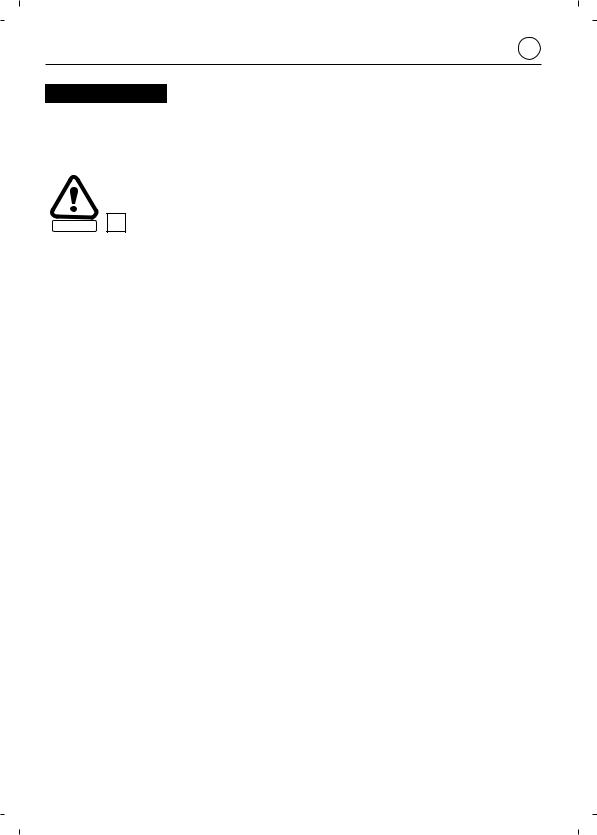
SICHERHEITSHINWEISE |
D |
|
Bitte beachten Sie besonders die Hinweise, die nach den folgenden vier Zeichen stehen:
 WARNUNG :
WARNUNG :
Gefahr schwerer Verletzungen bei Nichtbeachtung dieses Hinweises.
VORSICHT:
• Hinweis auf Verletzungsgefahr des Bedieners oder auf Beschädigungsgefahr für das Gerät.
ZUR BEACHTUNG: Nützliche, praktische Hinweise.
Dieses Zeichen mahnt zur Vorsicht bei gewissen Handgriffen und bittet Sie, die Sicherheitshinweise mit den genannten Nummern zu beachten.
SICHERHEIT
ANLEITUNG
A1. Lesen Sie das vorliegende Handbuch aufmerksam durch. Machen Sie sich mit der Funktionsweise und Bedienung des Rasenmähers vertraut, bevor Sie diesen benutzen. Sie müssen in der Lage sein, den Motor rasch abzuschalten.
A2. Verwenden Sie den Rasenmäher ausschließlich zum vorgesehenen Zweck, d.h. zum Mähen des Rasens und Sammeln des Schnittgutes. Der Einsatz zu anderen Zwecken kann gefährlich sein oder zu Schäden am Gerät führen.
A3. Kinder sowie Personen, die mit den Anwendungshinweisen nicht vertraut sind, dürfen den Rasenmäher keinesfalls bedienen. Im Rahmen der lokalen Gesetzgebung kann ein Mindestalter für den Benutzer festgesetzt sein.
A4. Den Rasenmäher nicht benutzen, wenn:
-Sich Personen, insbesondere Kinder, oder Tiere in der Nähe aufhalten;
-Der Benutzer Medikamente oder Substanzen eingenommen hat, die sein Reaktionsvermögen und seine Aufmerksamkeit einschränken können.
A5. Denken Sie immer daran, daß der Eigentümer oder Benutzer des Rasenmähers für Unfälle und Schäden haftet, die Dritten bzw. am Eigentum von Dritten entstehen.
VORBEREITUNG
B1. Tragen Sie beim Mähen immer festes Schuhwerk und lange Hosen. Benutzen Sie den Rasenmäher keinesfalls, wenn Sie keine Schuhe bzw. Sandalen tragen.
B2. Prüfen Sie die betreffende Rasenfläche zunächst gründlich und entfernen Sie eventuelle Fremdkörper, die durch den Rasenmäher aufgeschleudert werden könnten (Steine, Holzstücke, Drähte, Knochen etc...).
B3. ACHTUNG: GEFAHR ! Benzin ist feuergefährlich.
-Bewahren Sie Benzin in Behältern auf, die speziell für diesen Zweck bestimmt sind.
-Betanken Sie den Rasenmäher nur im Freien bei ausgeschaltetem Motor. Rauchen Sie nicht, während Sie mit Benzin umgehen.
-Wenn der Motor in Betrieb oder noch warm ist, darf der Deckel des Benzintanks keinesfalls geöffnet bzw. Benzin eingefüllt werden.
-Starten Sie den Motor nicht, wenn Benzin verschüttet wurde: entfernen Sie den Rasenmäher aus dem betreffenden Bereich und vermeiden Sie offene Flammen, solange sich das Benzin und die Dämpfe nicht verflüchtigt haben.
-Verschließen Sie den Deckel des Tanks und Benzinbehälters wieder sorgfältig.
-Vor dem Kippen des Rasenmähers für Arbeiten am Messer oder zum Auslaufenlassen des Öls den Kraftstofftank leeren.
B4. Defekte Auspuffschalldämpfer müssen ausgetauscht werden.
B5. Vor jedem Einsatz muß der Rasenmäher einer allgemeinen Überprüfung unterzogen werden; insbesondere sind die Schneidmesser, Befestigungsbolzen und die gesamte Schneideinheit auf Verschleiß oder Beschädigungen zu prüfen. Sind Teile beschädigt oder abgenutzt, so ist jeweils der komplette Teilesatz auszutauschen.
BEDIENUNGSELEMENTE UND BAUGRUPPEN
C1. Schalten Sie den Motor nicht in geschlossenen Räumen ein, in denen sich die schädliche Kohlenmonoxidgase ansammeln können.
C2. Benutzen Sie den Rasenmäher nur bei Tageslicht bzw. bei guter Beleuchtung. C3. Das Mähen von nassem Gras sollte nach Möglichkeit vermieden werden.
C4. Halten Sie während der Arbeit immer einen ausreichenden Sicherheitsabstand zum Schneidmesser ein, der durch die Länge der Lenkstange gegeben ist.
C5. Achten Sie darauf, daß Sie beim Mähen gehen und nicht laufen. Lassen Sie sich vom Rasenmäher nicht “vorwärtsziehen”.
6

D |
SICHERHEITSHINWEISE |
|
C6. Achten Sie in abschüssigem Gelände auf einen sicheren Schritt. Mähen Sie quer zum Hang und keinesfalls in aufoder absteigender Richtung.
C7. Bei Richtungswechseln in abschüssigem Gelände ist besondere Vorsicht geboten. C8. Bei mehr als 20° Gefälle darf der Rasenmäher nicht eingesetzt werden.
C9. Seien Sie besonders vorsichtig, wenn Sie den Rasenmäher zu sich herziehen.
C10. Das Schneidmesser muß abgeschaltet werden, wenn der Rasenmäher beim Transport oder der Verlagerung von einer Rasenfläche zur nächsten gekippt werden muß.
C11. Der Rasenmäher darf keinesfalls benutzt werden, wenn die Schutzvorrichtungen oder das Gehäuse beschädigt sind oder Sicherheitsteile wie das Ablenkblech oder die Fangbox fehlen.
C12. Die Einstellung des Motorreglers darf keinesfalls verändert werden. Achten Sie darauf, daß der Motor nicht überdreht.
C13. Entriegeln Sie vor dem Starten des Motors das Schneidmesser (bei Geräten mit Rotostop) und die Vorschubkupplung (bei Geräten mit Eigenantrieb).
C14. Schalten Sie den Motor vorsichtig ein; beachten Sie dabei die Anwendungshinweise und halten Sie einen ausreichenden Sicherheitsabstand zum Schneidmesser ein.
C15. Der Rasenmäher darf beim Starten nicht gekippt werden. Schalten Sie das Gerät auf einer ebenen Fläche ein, auf der sich weder Hindernisse noch hohes Gras befinden.
C16. Hände und Füße müssen sich in ausreichendem Abstand zu rotierenden Teilen befinden. Halten Sie immer einen ausreichenden Sicherheitsabstand zum Auswurf.
C17. Der Rasenmäher darf keinesfalls angehoben oder transportiert werden, solange der Motor in Betrieb ist. C18. In folgenden Fällen muß der Motor abgeschaltet und der Zundkerzenstecker abgezogen werden:
-Vor jedem Eingriff unter dem Schneidgehäuse oder im Auswurfkanal.
-Vor der Reinigung, Überprüfung oder Reparatur des Rasenmähers.
-Nach dem Kontakt mit einem Fremdkörper. In diesem Fall muß der Rasenmäher auf eventuelle Beschädigungen überprüft werden. Vor dem erneuten Einsatz des Gerätes sind die erforderlichen Reparaturen auszuführen.
-Wenn der Rasenmäher in anormaler Weise vibriert. Die Ursache der Vibrationen muß sofort ermittelt und beseitigt werden.
C19. In folgenden Fällen ist der Motor abzuschalten:
-Immer wenn der Rasenmäher nicht beaufsichtigt ist.
-Vor dem Betanken des Rasenmähers.
C20. In folgenden Fällen (bei Geräten mit Rotostop) ist der Motor abzuschalten:
-Vor dem Einstellen der Schnitthöhe.
-Bei der Montage und Demontage der Grasfangsackes.
C21. Nehmen Sie das Gas weg, bevor Sie den Motor abschalten. Den Benzinhahn schließen.
INSTANDHALTUNG UND LAGERUNG
D1. Um sichere Einsatzbedingungen zu gewährleisten, müssen sämtliche Schrauben und Muttern angezogen sein. Die regelmäßige Wartung des Rasenmähers ist eine wesentliche Voraussetzung für die Erhaltung der Sicherheit und Leistung des Gerätes.
D2. Der Rasenmäher darf keinesfalls mit gefülltem Tank in einem Raum gelagert werden, wo die Benzindämpfe mit einer offenen Flamme, Funken oder einer starken Wärmequelle in Kontakt kommen könnten.
D3. Lassen Sie den Motor abkühlen, bevor Sie den Rasenmäher in einem Raum unterbringen.
D4. Beseitigen Sie Blätter, Grashalme und überschüssiges Fett, die sich am Rasenmäher, insbesondere am Motor und Auspufftopf, sowie im Lagerungsbereich des Benzins befinden; so reduzieren Sie die Brandgefahr. Lagern Sie Container mit Gartenabfällen nicht in einem geschlossenen Raum oder in unittelbarer Umgebung eines Raumes.
D5. Wenn der Kraftstofftank entleert werden muß, so darf dies nur im Freien und bei kaltem Motor geschehen. D6. Prüfen Sie die Schnittgut-Sammeleinheit in regelmäßigen Abständen auf Verschleiß oder Beschädigungen.
D7. Verwenden Sie den Rasenmäher nicht, wenn Teile beschädigt oder abgenutzt sind. Die Teile dürfen nicht repariert, sondern müssen ausgetauscht werden. Verwenden Sie dazu Originalteile von Honda. Die Schneidmesser müssen immer mit der Marke Honda sowie einer Referenz gekennzeichnet sein. Teile anderer Güte können zu Schäden am Gerät führen und Ihre Sicherheit beeinträchtigen.
D8. Tragen Sie bei der Demontage und Montage des Schneidmessers dicke Handschuhe, oder beim Reinigung des Mähewerks. Zum Festziehen und Lösen des Messers die Messerdrehung mittels eines Holzblocks blockieren.
D9. Achten Sie beim Schärfen des Schneidmessers darauf, daß seine Gleichmäßigkeit erhalten bleibt.
7

SAFETY INSTRUCTIONS |
GB |
|
Headings preceded by the following words must be read very carefully:
WARNING :
Indicates that there is danger of serious bodily injury or even death if instructions are not followed.
CAUTION:
•Indicates that there is a possible risk of bodily injury or equipment damage if instructions are not followed.
SAFETY
NOTE: Source of useful information.
This sign means that you must take care during certain operations. Refer to the safety instructions on the following pages, to the point(s) indicated in the square.
TRAINING
A1. Read the instructions carefully. Be familiar with the controls and the proper use before using the equipment. Know how to stop the engine rapidly.
A2. Use the mower for the purpose it is intended for, that is mowing and collecting grass. Any other use could be dangerous or damage the equipment.
A3. Never allow children or people unfamiliar with these instructions to use the lawn mower. Local regulations may restrict the age of the operator.
A4. Never mow when:
-People, especially children or pets are nearby.
-User is under medication or has swallowed substances known to affect judgement or reactions.
A5. Keep in mind that the owner or user is responsible for accidents or hazards occurring to other people or their property.
PREPARATION
B1. While mowing, always wear substantial footwear and long trousers. Do not operate the equipment when barefoot or wearing sandals.
B2. Thoroughly inspect the area where the equipment is to be used and remove all objects which may be thrown by the machine (stones, branches, wires, bones, etc...).
B3. WARNING - Petrol is highly flammable.
-Store fuel in containers specifically designed for this purpose.
-Refuel outdoors only, before starting the engine and do not smoke while refuelling or handling fuel.
-Never remove the cap of the fuel tank or add petrol while the engine is running or when the engine is hot.
-If petrol is spilled, do not attempt to start the engine but move the machine away from the area of spillage and avoid creating any source of ignition until petrol vapours are dissipated;
-Replace all fuel tanks and container caps securely.
-Before tipping the lawn mower to maintain the blade or drain oil, remove fuel from tank.
B4. Replace faulty silencers.
B5. Before use, always visually inspect the machine, especially to see that the blades, blade bolts and cutter assembly are not worn or damaged. Replace worn or damaged blades and bolts in sets to preserve balance.
OPERATION
C1. Do not operate the engine in a confined space where dangerous carbon monoxide fumes can collect. C2. Mow only in daylight or in good artificial light.
C3. Avoid operating the equipment in wet grass, where feasible.
C4. While mowing, always keep the safety distance to the blade, which is provided by the handle length. C5. Walk, never run. Do not let yourself be pulled by the mower.
8

GB |
SAFETY INSTRUCTIONS |
|
C6. Always be sure of your footing on slopes. Mow across the face of slopes, never up and down. C7. Exercise extreme caution when changing direction on slopes.
C8. Do not mow slopes of more than 20°.
C9. Use extreme caution when pulling the lawn mower towards you.
C10. Stop the blade if the lawn mower has to be tilted for transportation when crossing surfaces other than grass, and when transporting the lawn mower to and from the area to be mowed.
C11. Never operate the lawn mower with defective guards or housings, or without safety devices such as deflectors and/or grass catchers.
C12. Do not change the engine governor settings or overspeed the engine.
C13. Disengage all blade (models equipped with Rotostop) and drive clutches (self-propelled models) before starting the engine.
C14. Start the engine carefully according to instructions and with feet well away from the blade.
C15. Do not tilt the lawn mower when starting the engine. Start the mower on a level surface, free of high grass or obstacle.
C16. Keep hands and feet away from the rotating parts. Do not start the engine when standing in front of the discharge opening.
C17. Never pick up or carry a lawn mower while the engine is running.
C18. Stop the engine and disconnect the spark plug cap in the following cases:
-Before any operation under the cutter housing or the discharge tunnel.
-Before checking, cleaning or working on the lawn mower.
-After striking a foreign object. Inspect the lawn mower for damage and make repairs before restarting and operating the lawn mower again.
-If lawn mower starts to vibrate abnormally. Check immediately the cause of the vibration and perform the necessary repair.
C19. Stop the engine in the following cases:
-Whenever you leave the lawn mower unattended.
-Before refuelling.
C20. Stop the blade (models equipped with Rotostop) or the engine in the following cases:
-When installing or removing the grass bag.
-Before adjusting the cutting height.
C21. Reduce the throttle setting during engine shut-down. Close the fuel shut-off valve by turning the fuel shut-off valve.
MAINTENANCE AND STORAGE
D1. Keep all nuts, bolts and screws tight to be sure the equipment is in safe working condition. Regular maintenance is an essential aid to user’s safety and retaining a high level of performance.
D2. Never store the equipment with petrol in the tank inside a building when vapours may reach an open flame, spark or high temperature source.
D3. Allow the engine to cool before storing in any enclosure.
D4. To reduce the fire hazard, keep the mower, especially the engine and silencer, the petrol storage area as well, free of grass, leaves, or excessive grease. Do not leave containers of vegetable matters in or near a building.
D5. If the fuel tank has to be drained, this should be done outdoors, with a cold engine. D6. Check the grass collecting system frequently for wear or deterioration.
D7. Do not use the machine with worn or damaged parts. Parts must be replaced, not repaired. Replace worn or damaged parts with Honda genuine parts. Blades must always bear the mark Honda and the reference number. Non equivalent quality parts may damage the machine and be prejudicial to your safety.
D8. Wear thick gloves when removing or installing the blade or when cleaning the cutter housing. When tightening or loosening the blade screws, use a wooden block to prevent the blade from rotating.
D9. Always make sure the correct balance of the blade when sharpening.
9
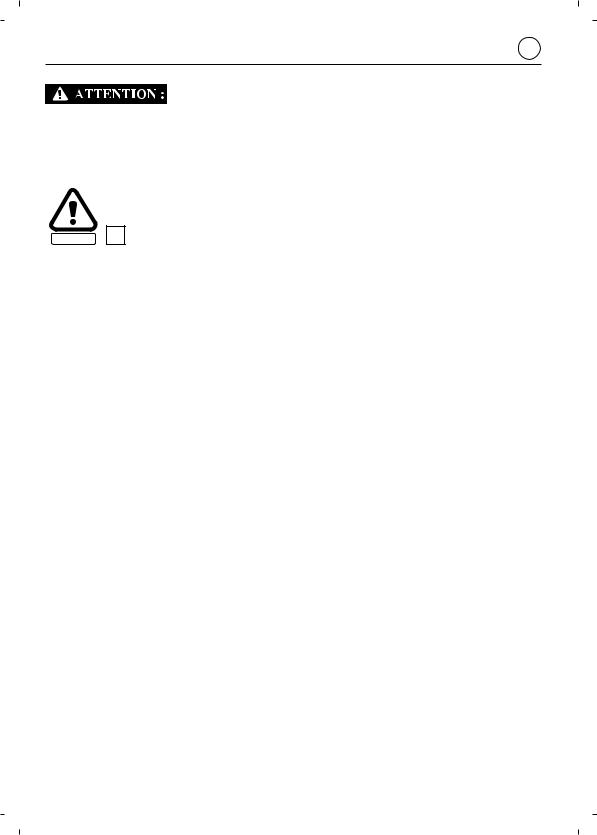
CONSIGNES DE SÉCURITÉ |
F |
|
Il convient de prêter une grande attention aux rubriques qui sont précédées des mots suivants :
Mise en garde contre un risque de blessures corporelles graves ou même de mort, en cas de non observation des instructions.
PRÉCAUTION :
•Mise en garde contre un éventuel risque de blessures corporelles ou d’endommagement du matériel, en cas de non-observation des instructions.
SECURITE
NOTE: Source d’informations utiles.
Ce signe vous appelle à la prudence lors de certaines opérations. Se reporter aux consignes de sécurité des pages suivantes, au(x) point(s) indiqué(s) dans le carré.
FORMATION
A1. Lire attentivement les instructions du présent manuel. Se familiariser avec l’utilisation correcte et les commandes avant d’utiliser la tondeuse. Savoir arrêter le moteur rapidement.
A2. Utiliser la tondeuse pour l’usage auquel elle est destinée, à savoir la tonte et le ramassage du gazon. Toute autre utilisation peut s’avérer dangereuse ou entraîner une détérioration de la machine.
A3. Ne jamais permettre d’utiliser la tondeuse à des enfants ou des personnes non familières avec les instructions. La réglementation locale peut fixer un âge limite pour l’utilisateur.
A4. Ne pas utiliser la tondeuse lorsque :
-Des personnes, particulièrement des enfants, ou des animaux se trouvent à proximité.
-L’utilisateur a absorbé des médicaments ou substances, réputés comme pouvant nuire à sa capacité de réflexe et de vigilance.
A5. Garder à l’esprit que le propriétaire ou l’utilisateur est responsable des accidents ou des risques encourus par les tierces personnes ou par leurs biens.
PRÉPARATION
B1. Toujours porter des chaussures résistantes et des pantalons longs pendant la tonte. Ne pas utiliser le matériel lorsque l’on est pieds nus ou en sandales.
B2. Inspecter minutieusement la zone à tondre et éliminer tout objet étranger qui pourrait être projeté par la machine (pierres, morceaux de bois, fil de fer, os, etc...).
B3. ATTENTION : DANGER ! L’essence est hautement inflammable.
-Conserver le carburant dans des récipients spécialement prévus à cet effet.
-Faire le plein à l’extérieur uniquement, avant de démarrer le moteur et ne pas fumer pendant cette opération ou toute manipulation de carburant.
-Ne jamais enlever le bouchon du réservoir de carburant ou faire le plein lorsque le moteur est en fonctionnement ou tant qu’il est encore chaud.
-Ne pas démarrer le moteur si de l’essence a été répandue : éloigner la tondeuse de la zone où le carburant a été renversé et ne provoquer aucune étincelle tant que le carburant ne s’est pas évaporé et que les vapeurs ne se sont pas dissipées.
-Refermer correctement le réservoir et le récipient en serrant convenablement les bouchons.
-Avant de pencher la tondeuse afin d’intervenir sur la lame ou de vidanger l’huile, vider le réservoir de carburant.
B4. Remplacer les silencieux d’échappement défectueux.
B5. Avant chaque utilisation, toujours procéder à une vérification générale et en particulier de l’aspect des lames, des boulons de fixation et de l’ensemble de coupe pour s’assurer qu’ils ne sont ni usés ni endommagés. Remplacer les pièces endommagées ou usées par lots complets pour préserver le bon équilibrage.
UTILISATION
C1. Ne pas faire fonctionner le moteur dans un endroit confiné, où les vapeurs nocives de monoxyde de carbone peuvent s’accumuler.
C2. Tondre uniquement à la lumière du jour ou dans une lumière artificielle de bonne qualité. C3. Dans la mesure du possible, éviter de tondre de l’herbe mouillée.
C4. Pendant le travail, conserver la distance de sécurité par rapport à la lame, donnée par la longueur du guidon.
10

F |
CONSIGNES DE SÉCURITÉ |
|
C5. Marcher, ne jamais courir. Ne pas se faire tirer par la tondeuse.
C6. Assurer ses pas dans les pentes. Tondre les pentes dans le sens transversal, jamais en montant ou en descendant. C7. Etre particulièrement prudent lors des changements de direction sur les terrains en pente.
C8. Ne pas tondre sur des pentes supérieures à 20°.
C9. Faire particulièrement attention lorsque la machine doit être tirée vers soi.
C10. Arrêter la lame si la tondeuse doit être inclinée pour le transport et lors des déplacements entre les surfaces à tondre.
C11. Ne jamais utiliser la tondeuse si ses protecteurs ou carters sont endommagés, ou en l’absence de dispositifs de sécurité comme le déflecteur ou le bac de ramassage.
C12. Ne jamais modifier le réglage du régulateur du moteur, ni mettre le moteur en surrégime.
C13. Avant de démarrer le moteur, désengager la lame (modèles équipés de Rotostop) et l’embrayage d’avancement (modèles autopropulsés).
C14. Démarrer le moteur avec précaution, en respectant les consignes d’utilisation et en tenant les pieds éloignés de la lame.
C15. Ne pas incliner la tondeuse pour le démarrage. Effectuer la mise en marche sur une surface plane, exempte de tout obstacle et d’herbe haute.
C16. Tenir les mains et les pieds éloignés des pièces tournantes. Toujours se tenir à l’écart de la goulotte d’éjection. C17. Ne jamais soulever ou transporter une tondeuse dont le moteur est en fonctionnement.
C18. Arrêter le moteur et débrancher le fil de bougie dans les cas suivants :
-Avant toute intervention sous le carter de coupe ou dans le tunnel d’éjection.
-Avant toute opération de nettoyage, de vérification ou de réparation de la tondeuse.
-Après avoir heurté un objet étranger. Inspecter la tondeuse pour vérifier si elle est endommagée. Effectuer les réparations nécessaires avant toute nouvelle utilisation de la machine.
-Si la tondeuse commence à vibrer de manière anormale. Rechercher immédiatement la cause des vibrations et y remédier.
C19. Arrêter le moteur dans les cas suivants :
-Toutes les fois où la tondeuse doit être laissée sans surveillance.
-Avant de faire le plein de carburant.
C20. Arrêter la lame (modèles équipés d’un Rotostop) ou le moteur dans les cas suivants :
-Lors de la pose et la dépose du sac de ramassage.
-Avant de régler la hauteur de coupe.
C21. Réduire les gaz avant d’arrêter le moteur. Fermer le robinet d’arrivée d’essence après chaque utilisation.
MAINTENANCE ET STOCKAGE
D1. Maintenir tous les écrous et vis serrés afin d’assurer des conditions d’utilisation sûres. Un entretien régulier est essentiel pour la sécurité et le maintien du niveau de performances.
D2. Ne jamais entreposer la tondeuse avec du carburant dans le réservoir dans un local où les vapeurs d’essence pourraient atteindre une flamme, une étincelle ou une forte source de chaleur.
D3. Laisser le moteur refroidir avant de ranger la machine dans un local quelconque.
D4. Pour réduire les risques d’incendie, débarrasser la tondeuse, en particulier le moteur, le pot d’échappement, et la zone de stockage de carburant, des feuilles, brins d’herbe et des excès de graisse. Ne pas laisser de conteneurs de débris végétaux dans ou à proximité d’un local.
D5. Si le réservoir de carburant doit être vidangé, effectuer cette opération à l’extérieur et lorsque le moteur est froid. D6. Vérifier fréquemment que l’équipement de ramassage ne présente aucune trace d’usure ou de détérioration.
D7. Ne pas utiliser la machine avec des pièces endommagées ou usées. Les pièces doivent être remplacées et non pas réparées. Utiliser des pièces d’origine Honda. Les lames doivent toujours porter la marque Honda ainsi que la référence. Des pièces de qualité non équivalente peuvent endommager la machine et nuire à votre sécurité.
D8. Porter des gants épais pour le démontage et le remontage de la lame de coupe ou lors du nettoyage du carter de coupe. Pour le serrage et desserrage de la lame, utiliser une cale en bois pour bloquer sa rotation.
D9. Veiller au maintien de l’équilibrage de la lame lors de son affûtage.
11

EINFÜHRUNG |
|
|
D |
|||
|
|
|
||||
|
|
|
|
|
|
|
|
|
D |
|
GB |
F |
|
|
|
|
|
|
|
|
Modell |
|
|
|
HRB425C |
|
|
Model |
|
|
|
|
||
|
|
|
|
|
||
Modèle |
|
|
|
|
|
|
|
|
S= Selbstfahrende |
S= Self-propelled models |
S= Modèles autotractés |
||
|
|
Modell |
mit |
with gearbox |
à transmission |
|
|
S |
Schaltgetriebe |
|
mécanique |
||
|
P= Modell |
ohne |
P= Push-type models |
P= Modèles poussés |
||
|
|
Radantrieb |
|
|
|
|
|
|
Q= Modell mit |
hinterer |
Q= Rear roller models |
Q= Modèles avec rouleau |
|
Typen |
|
Rolle |
|
|
arrière |
|
|
|
|
|
|
||
Types |
|
D= Modell mit |
|
D= Models fitted with |
D= Modèles équipés d'un |
|
Types |
|
|
||||
|
Messerbremse |
flywheel brake |
frein de lame |
|||
/ |
|
|||||
|
X= Modell mit |
|
X= Models fitted |
X= Modèles équipés d'un |
||
Wahl |
X |
|
||||
Messerkupplung |
with blade |
embrayage de lame |
||||
Option |
||||||
|
(Rotostop) |
|
clutch (Rotostop) |
(Rotostop) |
||
Option |
|
|
||||
|
Q= Model mit hinterer |
Q= Models with rear roller |
Q= Modèles équipés d'un |
|||
|
|
|||||
|
|
Rolle |
|
|
rouleau arrière |
|
|
E |
E= Europa-Länder- |
E= Destination |
E= Destination |
||
|
Kennzeichen |
|
|
|||
|
|
|
|
|
|
|
|
|
|
|
|
|
|
Beispiel/Example/Exemple :
HRB425C |
S X E |
D
Sie haben einen Rasenmäher von Honda erworben. Wir bedanken uns für Ihr Vertrauen und beglückwünschen Sie zur Ihrem Kauf.
Bitte lesen Sie die Anleitung vor Inbetriebnahme aufmerksam durch. Sie wurde geschrieben, um Ihnen zahlreiche, praktische Hinweise zu geben, damit Sie die notwendige Wartung vornehmen können, die Ihnen jene dauerhafte Freude sichert, die Sie von einem Honda-Erzeugnis erwarten dürfen.
Beachten Sie bitte auch, daß Honda unaufhörlich an der technologischen Verbesserung seiner Erzeugnisse arbeitet und bemüht ist, sie durch Ersatz neuer Materialien und ständig verbesserter Herstellungsmethoden in den Genuß eines Spitzenerzeugnisses zu bringen. Es ist daher möglich, daß Ihr Gerät eventuell in kleinen Details nicht ganz der vorliegenden Bedienungsbzw. Betriebsanleitung entspricht. Wir danken für Ihr Verständnis für diesen Vorbehalt, der technische Änderungen ohne vorherige Ankündigung betrifft und der bei hochwertigen Geräten allgemein üblich ist.
Sollten Fragen oder Probleme auftauchen, die in der vorliegenden Schrift nicht behandelt werden, so wenden Sie sich bitte an Ihr Honda Fachgeschäft, oder an die Kundendienst-Abteilung elner Honda-Verkaufsniederlassung.
Wir empfehlen, diese Betriebsanleitung in der Nähe Ihres Gerätes aufzubewahren, damit sie bei Bedarf sofort greifbar ist. Sollten Sie Ihr Gerät später einmal durch ein neues ersetzen, so wird Ihnen Ihr Käufer für die Überlassung dieser Anleitung dankbar sein.
Bitte lesen Sie auch die separat beiliegende Garantie-Urkunde. Sie enthält wichtige Hinweise, die Ihre und unsere Rechte und Pflichten betreffen.Vervielfältigung oder Nachdruck der vorliegenden Anleitung sind ohne vorherige, schriftliche Zustimmung nicht gestattet.
ERKLÄRUNG DER IN DIESER BEDIENUNGSANLEITUNG VERWENDETEN SYMBOLE (Sehen Sie bitte die Tabelle auf Seite 12)
ZUR BEACHTUNG: Die Abbildungen dieser Anleitung zeigen das Modell HRB425C SXE.
Erste Ausgabe: 06/98
12

GB |
INTRODUCTION |
|
Dear Honda User,
You have just purchased a Honda lawn mower and we thank you for your confidence in us.
This manual has been written to familiarise you with your mower, to enable you to use it in the best possible conditions and to carry out its maintenance.
Our aim is to make you benefit to the full from technological advances, from new equipment and materials and from our experience. This is why we regularly make improvements to our models. Thus, the specifications and information contained in this manual may be modified without prior notice and without obligation to update it.
If you have a problem, or if you have any questions concerning the mower, contact your supplying dealer or approved Honda dealer.
Keep this manual handy so you can consult it at any time. If you sell the mower be sure that the manual accompanies it.
We recommend that you read the guarantee policy to fully understand your rights and responsibilities. The guarantee policy is a separate document provided by your dealer.
No reproduction, even partial, may be made of this publication without prior written authorisation.
DESCRIPTION OF THE CODES USED IN THIS MANUAL (See table on p. 12)
NOTE: The illustrations in this manual correspond to model HRB425C SXE.
1st Edition: 06/98
F |
INTRODUCTION |
|
Madame, Monsieur,
Vous venez de faire l’acquisition d’une tondeuse à gazon Honda et nous vous remercions de votre confiance.
Ce manuel a été établi pour vous familiariser avec votre tondeuse, vous permettre de l’utiliser dans les meilleures conditions et d’effectuer son entretien.
Soucieux de vous faire profiter au maximum des évolutions technologiques, des nouveaux équipements ou matériaux et de notre expérience, les modèles sont régulièrement améliorés ; c’est pourquoi les caractéristiques et les renseignements contenus dans ce manuel peuvent être modifiés sans avis préalable et sans obligation de mise à jour.
En cas de problème ou encore pour toute question relative à la tondeuse, adressez-vous à votre concessionnaire ou à un revendeur agréé Honda.
Conservez ce manuel à portée de main pour le consulter à tout moment et assurez-vous, qu’en cas de revente, il accompagne bien la tondeuse.
Nous vous recommandons de lire la police de garantie pour bien comprendre vos droits et vos responsabilités. La police de garantie est un document séparé fourni par votre concessionnaire.
Aucune reproduction, même partielle, de la présente publication, ne peut se faire sans autorisation écrite préalable.
EXPLICATION DES CODES UTILISÉS DANS CE MANUEL (Voir tableau p. 12)
NOTE: Les illustrations de ce manuel correspondent au modèle HRB425C SXE.
1ère édition : 06/98
13
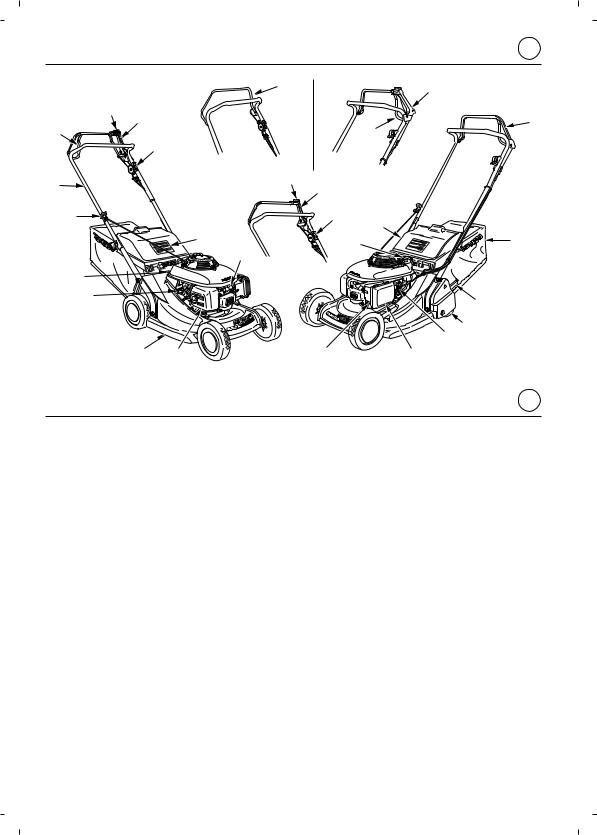
RUNDLEGENDE ERKLÄRUNGEN |
|
D |
||
|
|
|||
|
|
18 |
|
2 |
|
|
|
|
|
1 |
|
|
|
|
2 |
|
|
17 |
18 |
17 |
|
|
|
|
|
|
|
|
|
|
3 |
|
|
|
|
|
PDE - QDE |
QXE |
|
16 |
|
1 |
|
|
|
2 |
|
|
|
|
|
|
|
|
15 |
|
|
3 |
6 |
|
|
|
|
|
|
|
A |
10 |
5 |
|
|
|
||
|
|
|
|
|
|
|
11 |
|
|
B |
|
PXE - PQX |
|
|
|
|
|
|
|
14 |
|
|
|
7 |
|
|
|
|
|
|
|
|
|
19 |
|
|
|
|
4 |
12 |
13 |
9 |
|
8 |
|
SQE |
|
||
|
|
|
|
|
SXE
D
BEZEICHNUNG DER BAUTEILE
|
BAUTEILE |
FUNKTION |
1* |
Verriegelung Messerkupplung . . . . . . . . |
Verhindert unbeabsichtigtes |
|
|
Ingangsetzen des Messerblattes |
2* |
Messerkupplung . . . . . . . . . . . . . . . . . . . |
Start und Stop des Mähmessers |
3 |
Gashebel . . . . . . . . . . . . . . . . . . . . . . . . |
Motordrehzahlregelung |
4 |
Kraftstoffhahn . . . . . . . . . . . . . . . . . . . . . |
Zum Öffnen und Schließen der |
|
|
Bezinzufuhr |
5 |
Grassack . . . . . . . . . . . . . . . . . . . . . . . . . |
Sammelt das Mähgut |
6 |
Deckel . . . . . . . . . . . . . . . . . . . . . . . . . . . |
verhindert, daß Mähgut austritt |
7 |
Schnitthöhen-Einstellhebe . . . . . . . . . . . |
Einstellen der Rasenschnitthöhe |
8 |
Luftfilter |
|
9Vergaser
10Tankverschluß
11Zündkerzenstecker
12Messergehäuse
13Auspuff
14 |
Öltankverschluß . . . . . . . . . . . . . . . . . . . |
mit Meßstab zur Ölstandskontrolle |
15 |
Griff des Starterseilzugs . . . . . . . . . . . . . |
Zum Starten des Motors ziehen |
16 |
Lenkgrif |
|
17* |
Fahrkupplung . . . . . . . . . . . . . . . . . . . . . |
Setzt bei Geräten mit Rad-Antrieb die |
|
|
Hinterräder in Gang, oder Rollen antrieb |
18* |
Hebel der Messerbremse . . . . . . . . . . . . |
stoppt die Messerdrehung und den |
|
|
Motor |
19* |
Heckrolle |
|
* Nur bei Geräten, die mit dieser Baugruppe ausgestattet sind.
14

GB |
|
GENERAL DESCRIPTION |
|
|
|
EQUIPMENT IDENTIFICATION |
|
|
|
CONTROLS |
FUNCTIONS |
1* |
Blade clutch lever control button . . . . . . . |
Activates blade clutch lever |
2* |
Blade clutch lever . . . . . . . . . . . . . . . . . . |
Starts and stops blade rotation |
3 |
Throttle lever . . . . . . . . . . . . . . . . . . . . . . |
Controls engine speed |
4 |
Fuel shut-off valve. . . . . . . . . . . . . . . . . . |
Opens and closes the fuel inlet |
5 |
Grass bag . . . . . . . . . . . . . . . . . . . . . . . . |
Collects grass cuttings |
6 |
Discharge guard . . . . . . . . . . . . . . . . . . . |
Prevents objects being thrown by blade |
7 |
Cutting height adjustment lever. . . . . . . . |
Selects desired cutting height |
8 |
Air cleaner |
|
9Carburetor
10Fuel tank filler cap
11Spark plug cap
12Blade casing
13Muffler
14 |
Oil filler cap . . . . . . . . . . . . . . . . . . . . . . . |
Used to fill and drain oil, and to check oil |
|
|
level |
15 |
Starter grip . . . . . . . . . . . . . . . . . . . . . . . |
Pull to start engine |
16 |
Handle |
|
17* |
Drive clutch lever. . . . . . . . . . . . . . . . . . . |
Controls the transmission which drives |
|
|
rear wheels or rear roller |
18* |
Blade brake lever . . . . . . . . . . . . . . . . . . |
Stops blade rotating and engine |
19* |
Rear roller |
|
* Where fitted |
|
|
F |
|
DESCRIPTION GÉNÉRALE |
|
|
|
IDENTIFICATION DES ÉLÉMENTS |
|
|
|
COMMANDES |
FONCTIONS |
1* |
Bouton de commande du levier |
|
|
d’embrayage de lame . . . . . . . . . . . . . . . |
Active le levier d’embrayage de lame |
2* |
Levier d’embrayage de lame. . . . . . . . . . |
Démarre et arrête la rotation de la lame |
3 |
Manette de commande des gaz . . . . . . . |
Règle le régime moteur |
4 |
Robinet de carburant . . . . . . . . . . . . . . . |
Ouvre/ferme l’arrivée d’essence |
5 |
Sac de ramassage . . . . . . . . . . . . . . . . . |
Collecte l’herbe coupée |
6 |
Protecteur de décharge. . . . . . . . . . . . . . |
Evite les projections |
7Levier de réglage de la hauteur de coupe . Sélectionne la hauteur de coupe
souhaitée
8 Filtre à air
9Carburateur
10Bouchon du réservoir d’essence
11Capuchon de la bougie d’allumage
12Carter de lame
13Pot d’échappement
14 Bouchon de remplissage de l’huile . . . . . Permet le remplissage, la vidange et le contrôle du niveau d’huile
15 Poignée de lanceur . . . . . . . . . . . . . . . . . Permet la mise en marche du moteur 16 Guidon
17* |
Levier d’embrayage d’avancement . . . . . |
Commande la transmission qui entraîne |
|
|
les roues arrière ou le rouleau arrière |
18* |
Levier de frein de lame . . . . . . . . . . . . . . |
Arrête la rotation de la lame et le moteur |
19* |
Rouleau arrière |
|
* Pour les modèles équipés
15
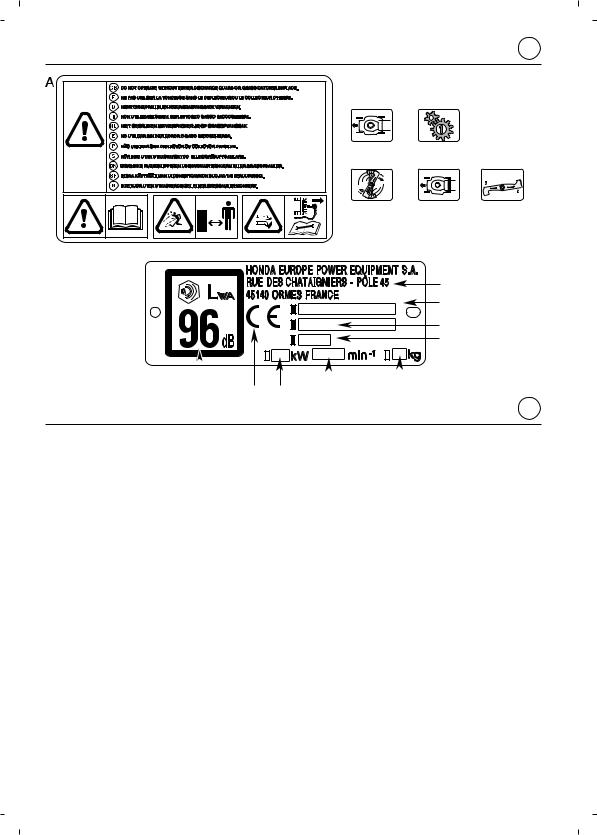
GRUNDLEGENDE ERKLÄRUNGEN |
D |
|
[13] |
[14] |
0 |
0 STOP |
1 |
|
|
|
01 |
|
|
|
|
|
|
0 |
|
|
[15] |
[16] |
[17] |
[10] |
[11] |
[12] |
|
|
B
9
8
7
6
|
|
|
|
|
|
|
|
|
|
|
|
|
|
|
|
|
|
|
|
|
|
|
|
1 |
2 |
3 |
4 |
5 |
|||
D
BESCHREIBUNG DER SICHERHEITSHINWEISE
Bitte seien Sie bei der Benutzung Ihres Rasenmähers vorsichtig. Aus diesem Grund haben wir am Gerät Symbole angebracht, die Sie auf die wichtigsten Vorsichtsmaßnahmen hinweisen. Die Bedeutung der Symbole ist unten erklärt.
Diese Aufkleber sind als Teil des Mähers zu betrachten. Sollte eines davon nicht angebracht oder nicht deutlich lesbar sein, setzen Sie sich bitte zwecks Ersatz mit Ihrem Honda-Händler in Verbindung.
Wir weisen auch noch einmal ausdrücklich auf die Sicherheltsanweisungen hin, die Sie im nächsten Kapitel der Bedienungsanleitung finden.
[10]Warnung: leser Sie vor dem Benutzen des Mähers die Bedienungsanleitung genau durch.
[11]Gefährdung von Personen. Bei Betrieb Dritte vom Gefahrenbereich fernhalten.
[12]Verletzungsgefahr. Gefahr durch umlaufende Schneidwerkzeuge. Hände und Füße fernhalten. Entfernen. Sie den Zündkersenstecker vor allen Wartungs oder Reparatur arbeiten.
ERKLÄRUNG DER IN DIESER BEDIENUNGSANLEITUNG VERWENDETEN SYMBOLE
[13] |
Modell mit vier Rädern |
[16] |
Modell mit hinterer Rolle |
[14] |
Modell mit Einzelngang Antrieb |
[17] |
Modell mit Messerbremse |
[15]Modell mit Messerkupplung (ROTOSTOP)
TYPENSCHILD DER MACHINE
1. |
Geräuschpegel nach Richtlinie 2000/14/EC |
6. |
Herstellungsjahr |
2. |
Konformitätszeichen gemäß der geänderten Richtlinie 89/392/EWG |
7. |
Seriennummer |
3. |
Leistung in Kilowatt |
8. |
Modell - Typ |
4. |
Motor-Drehzahl pro Minute |
9. |
Name und Anschrift des Herstellers |
5.Gewicht in Kilogramm
16

GB |
GENERAL DESCRIPTION |
|
SAFETY LABEL LOCATIONS
Your lawn mower must be used with care. Therefore, decals have been placed on the machine, to remind you pictorially of main precautions to take during use. Their meaning is explained below.
These decals are considered as a part of the mower. Should one become detached or unreadable, contact your Honda dealer for its replacement.
We also strongly recommend to carefully read the safety instructions given in the next chapter of this manual.
[10]Warning: Read the owner’s manual before using the mower.
[11]Risk of projections: Keep third persons away from the area during use.
[12]Risk of cuts. Rotating blade: Do not put hands or feet inside the blase enclosure. Disconnect the spark plug cap before performing any operation of maintenance or repairs.
DESCRIPTION OF THE SYMBOLS USED IN THIS MANUAL
[13] |
Four wheels models |
[16] |
Rear roller models |
[14] 1-Speed gear box models |
[17] |
Models equipped with blade brake |
|
[15] |
Models equipped with blade clutch (ROTOSTOP) |
|
|
IDENTIFICATION OF THE MACHINE
1. |
Acoustic power level according to the Directive 2000/14/EC |
6. |
Year of manufacture |
2. |
Conformity mark, according to the EEC/89/392 modified Directive |
7. |
Serial number |
3. |
Nominal power in kilowatt |
8. |
Model - Type |
4. |
Recommended engine speed in rpm |
9. |
Name and adress of the manufacture |
5. |
Mass in kilograms |
|
|
F |
DESCRIPTION GÉNÉRALE |
||
|
|
|
|
EMPLACEMENT DES ÉTIQUETTES DE SÉCURITÉ
Votre tondeuse doit être utilisée avec prudence. Dans ce but, des étiquettes destinées à vous rappeler les principales précautions d’utilisation ont été placées sur la machine sous forme de pictogrammes. Leur signification est donnée ci-dessous.
Ces étiquettes sont considérées comme partie intégrante de la tondeuse. Si l’une d’entre elles se détache ou devient difficile à lire, contactez votre concessionnaire pour la remplacer.
Nous vous recommandons également de lire attentivement les consignes de sécurité données au chapitre suivant du présent manuel.
[10]Attention : lire le manuel d’utilisateur avant l’utilisation de la tondeuse.
[11]Risque de projection. Tenir les tierces personnes en dehors de la zone pendant l’utilisation.
[12]Risque de coupure. Lame tournante. Ne pas introduire les mains et pieds dans l’enceinte de lame. Débrancher le capuchon de bougie avant toute opération d’entretien ou de réparation.
EXPLICATION DES SYMBOLES UTILISÉS DANS LE MANUEL
[13] |
Modèles à 4 roues |
[16] |
Modèles à rouleau arrière |
[14] |
Modèles à transmission mécanique monovitesse |
[17] |
Modèles équipés d’un frein de lame |
[15] |
Modèles équipés d’un embrayage de lame (ROTOSTOP) |
|
|
IDENTIFICATION DE LA MACHINE
1. Niveau sonore selon directive 2000/14/EC 6. Année de fabrication
2.Marquage de conformité, selon directive 89/392/CEE modifiée 7. Numéro de série
3. |
Puissance nominale en kilowatt |
8. |
Modèle - Type |
4. |
Vitesse d’utilisation du moteur en tours par minute |
9. |
Nom et adresse du constructeur |
5.Masse en kilogrammes
17
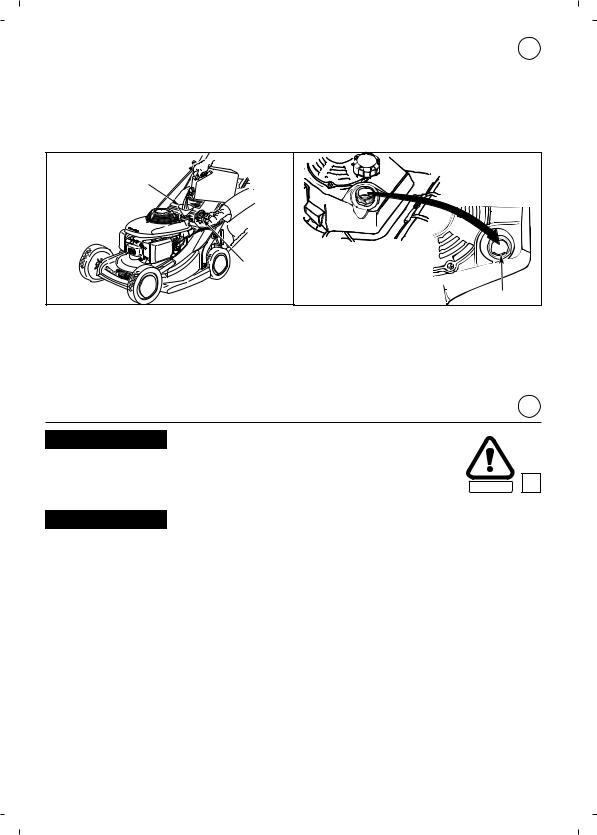
VORBEITUNGEN UND KONTROLLEN VOR INBETRIEBNAHME |
D |
|
[2]
[1]
[3]
D
 WARNUNG :
WARNUNG :
Zur Ausführung dieser Arbeiten stellen Sie bitte den Rasenmäher auf horizontalen, festen und grasfreien Boden. Zur Sicherheit ziehen Sie
den Zündkerzenstecker ab. B3
SICHERHEIT
KONTROLLE DES KRAFTSTOFFSTANDES
 WARNUNG :
WARNUNG :
Benzintank nie ganz vollfüllen. Im Einfüllstutzen darf sich kein Benzin befinden. Nach dem Bfüllen Tankverschluß zuschrauben.
Hände oder andere Körperteile nicht länger mit Benzin benetzen, Benzindämpfe nicht einatmen, Kinder fernhalten, nicht rauchen.
VORSICHT:
•Kein Benzin/Öl-Gemisch verwenden.
•Schmutz und Staub dürfen nicht in den Benzintank gelangen.
•Nur sauberes, frisches Benzin verwenden.
Benzinstandkontrolle:
1.Tankverschluß [1] abschrauben und Benzinstand kontrollieren.
2.Falls nötig, nachfüllen [2]. Nicht überfüllen, Füllstand kontrollieren [3].
3.Tankverschluß sorgfältig schließen [1].
ZUR BEACHTUNG: Normaloder Superbenzin, möglichst bleifrei, kein synthetisches Benzin oder Benzinersatz verwenden. Dies könnte die Zuleitungsschläuche beschädigen.
18
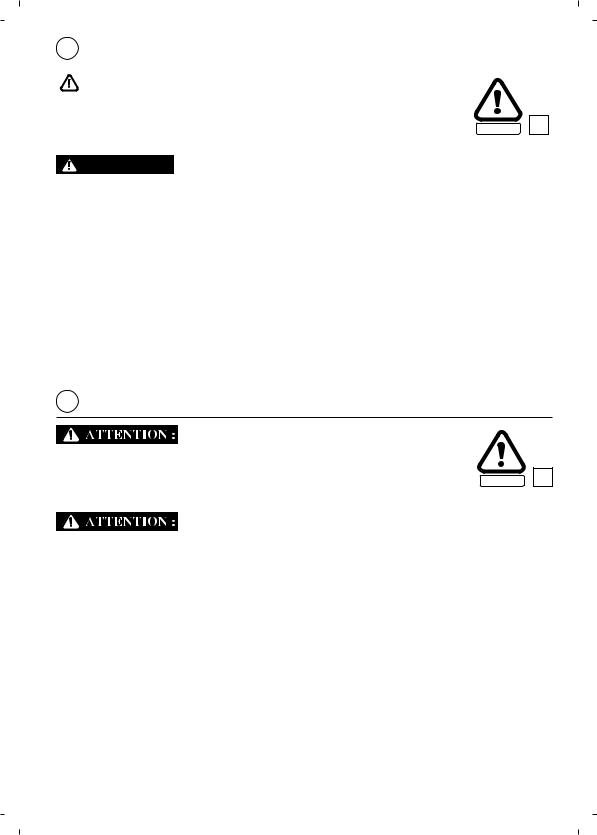
GB |
|
PREPARATIONS AND CHECKS BEFORE USE |
|
|
|
||
|
|
|
|
|
WARNING : |
|
|
To carry out this series of checks, plac the mower on stable and level |
|
||
ground with engine stopped and spark plug cap removed. |
|
||
CHECKING FUEL LEVEL |
SAFETY B3 |
||
|
|||
WARNING :
Do not fill the fuel tank up to the brim (there must be no fuel in the filler neck). When filling is completed, ensure that the tank filler cap is screwed fully on.
Avoid getting fuel on the skin repeatedly or for long periods and avoid breathing fuel vapours. Keep fuel away from children.
CAUTION:
•Never use a gas-oil mixture.
•Do not let dirt, clippings, etc. get into the tank.
•Do not use dirty or contaminated fuel (water, dust, ...), or fuel which is too old.
To check the fuel level:
1.Remove filler cap [1] and check fuel level.
2.Fill [2] tank if level is low. The maximum level is reached when the fuel is opposite mark [3].
3.Screw filler cap [1] fully on after filling.
NOTE: Fuel substitute products are not recommended. These may damage fuel system components.
F |
PRÉPARATIONS ET VÉRIFICATIONS AVANT UTILISATION |
|
Pour réaliser cette série de vérifications, placer la tondeuse sur un sol stable et de niveau, le moteur étant à l’arrêt et le capuchon de la bougie d’allumage retiré de la bougie.
SECURITE B3
VÉRIFICATION DU NIVEAU D’ESSENCE
Ne pas remplir à ras bord le réservoir d’essence (il ne doit pas y avoir d’essence dans le col de remplissage). Une fois le remplissage terminé, s’assurer que le bouchon du réservoir est vissé correctement et à fond.
Eviter tout contact répété ou prolongé d’essence avec la peau ainsi que toute inhalation de vapeurs d’essence. Ne pas laisser d’essence à la portée des enfants.
PRÉCAUTION :
•Ne jamais utiliser de mélange huile-essence.
•Prendre garde à ne pas laisser pénétrer de saletés dans le réservoir.
•Ne pas utiliser de carburant souillé (eau, poussière...) ou trop vieux.
Pour vérifier le niveau d’essence:
1.Dévisser le bouchon [1] et contrôler le niveau d’essence.
2.Remplir [2] le réservoir si le niveau est bas. Le niveau maximum est atteint lorsque l’essence se trouve en regard de la languette [3].
3.Revisser le bouchon [1] à fond après remplissage.
NOTE: Il n’est pas recommandé d’employer des produits de substitution à l’essence, qui peuvent nuire aux composants du circuit d’essence.
19
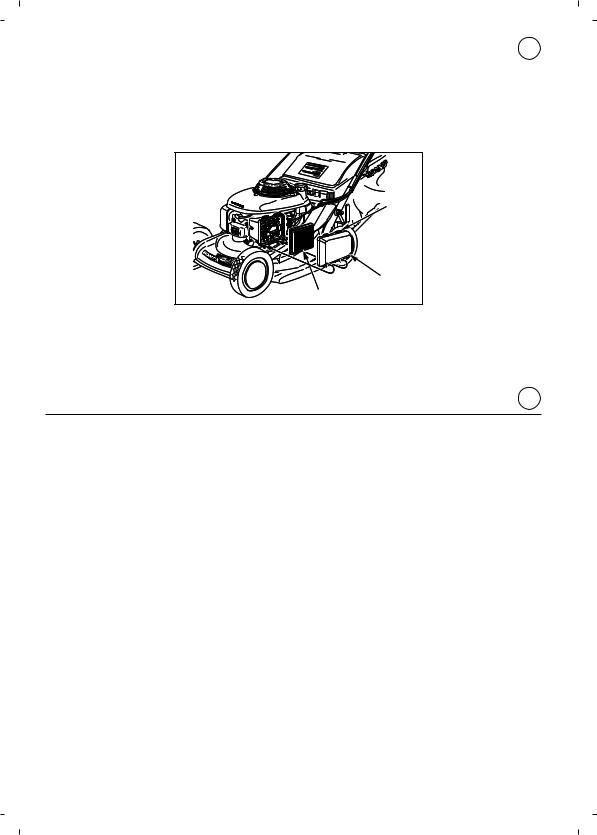
VORBEITUNGEN UND KONTROLLEN VOR INBETRIEBNAHME |
D |
|
[1] |
[2] |
[3] |
D
ALKOHOLHALTIGES BENZIN
Wenn Sie alkoholhaltiges Benzin verwenden, muß seine Oktanzahl mindestens der von Honda vorgeschriebenen entsprechen (86). Es gibt zwei Arten von Benzin/Alkohol-Gemischen: das eine enthält Äthylalkohol, das andere Methylalkohol.
Kein Gemisch mit mehr als 10% Äthylalkohol-Anteil verwenden.
Kein Benzin/Methylalkohol-Gemisch ohne Zusätze oder ohne Korrosionsschutzmittel und mit mehr als 5% Methylalkohol-Gehalt verwenden.
ZUR BEACHTUNG: Die Garantie schließt Schäden an den Benzinleitungen und schlechte Motorleistung aus, die durch Benutzung von alkoholhaltigem Benzin entstanden sind. Honda rät vom Gebrauch von Methylalkohol/Benzin-Gemischen ab, deren Nebenwirkungen noch nicht erprobt sind.
KONTROLLE DES LUFTFILTERS
VORSICHT:
•Den Motor nie ohne Luftfilter betreiben ! Dies würde zu schnellem Verschleiß von Kolben und Zylinder führen.
Kontrolle des Luftfilters:
1.Die Verriegelung [1] des Luftfilterdeckels [2] offnen und den Deckel abnehmen.
2.Kontrollieren Sie den Verschmutzungsgrad des Luftfilterelementes [3]. Solte dieses Filterelement verschmutzt sein, folgen Sie bitte den Reinigungsvorgaben (Kapitel Wartung).
3.Das Luftfilterelement [3] und den Deckel [2] wieder montieren.
20

GB |
PREPARATIONS AND CHECKS BEFORE USE |
|
FUEL CONTAINING ALCOHOL
If you intend to use fuel with alcohol, ensure that its octane number is at least as high as that recommended by Honda (86). There are two types of fuel/alcohol mixtures: one contains ethanol and the other methanol.
Do not use mixtures containing more than 10% ethanol, or fuel containing methanol (methyl or wood alcohol), which do not contain cosolvents, or corrosion inhibitors for methanol.
In the case of a mixture containing methanol with addition of cosolvents and corrosion inhibitors, limit the proportion to 5% of methanol.
NOTE: The guarantee does not cover damage caused to the fuel system or engine performance problems resulting from the use of fuel containing alcohol. Honda does not give its approval to the use of fuels containing methyl alcohol since their suitability is not yet proven.
CHECKING THE AIR CLEANER
CAUTION:
•Never run the engine without the air cleaner fitted since this could cause premature engine wear.
To check the condition of the air cleaner:
1.Press the latch tabs [1] on the top of the air cleaner cover and remove the cover [2].
2.Check the cleanliness of filter element [3].
If the element is dirty, follow the cleaning procedure (see Maintenance chapter).
3.Reinstall the filter [3] and air cleaner cover [2].
F |
PRÉPARATIONS ET VÉRIFICATIONS AVANT UTILISATION |
|
ESSENCE CONTENANT DE L’ALCOOL
Si vous avez l’intention d’employer de l’essence contenant de l’alcool, assurez-vous que son indice d’octane est au moins aussi élevé que celui que recommande Honda (86). Il existe deux types de mélange essence/alcool : l’un contenant de l’alcool éthylique et l’autre de l’alcool méthylique.
Ne pas employer de mélange qui contienne plus de 10 % d’alcool éthylique, ni d’essence contenant de l’alcool méthylique (méthyle ou alcool de bois), qui ne renferme ni cosolvants, ni inhibiteurs de corrosion pour l’alcool méthylique.
Dans le cas d’un mélange contenant de l’alcool méthylique avec addition de cosolvants et d’inhibiteurs de corrosion, limiter la proportion à 5 % d’alcool méthylique.
NOTE: La garantie ne couvre pas les dégâts causés au circuit d’essence ou encore les problèmes de performances du moteur qui résultent de l’emploi d’essence contenant de l’alcool. Honda ne saurait approuver l’usage de carburants contenant de l’alcool méthylique dans la mesure où leur caractère approprié n’a pas encore été prouvé.
VÉRIFICATION DU FILTRE À AIR
PRÉCAUTION :
•Ne jamais faire tourner le moteur sans le filtre à air, car il pourrait s’ensuivre une usure prématurée du moteur.
Pour vérifier l’état du filtre à air :
1.Presser les ergots [1] situés sur le dessus du couvercle de filtre à air et déverrouiller le couvercle [2].
2.Contrôler la propreté de l’élément filtrant [3]. Si l’élément est sale, suivre la procédure de nettoyage (voir chapitre Entretien).
3.Remonter le filtre [3] et le couvercle [2].
21
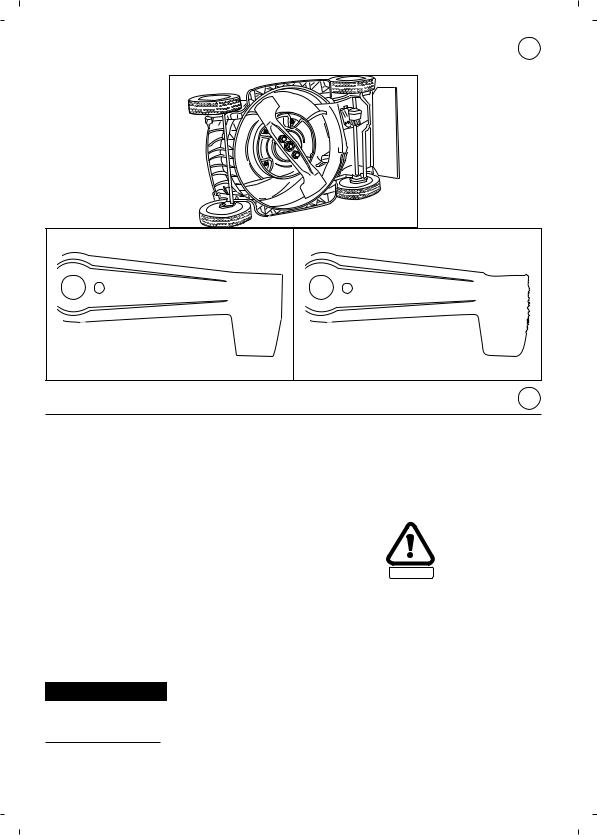
VORBEITUNGEN UND KONTROLLEN VOR INBETRIEBNAHME |
D |
|
[1] |
[2] |
|
D
KONTROLLE DES MESSERS
VORSICHT:
•Nur bei Motorstillstand und abgezogenem Kerzenstecker !
•Zur Inspektion des Messers und anderer Arbeiten am Messergehäuse, den Rasenmäher ausschließlich nach rechts kippen, sodaß der Vergaser nach oben gerichtet zum Liegen kommt.
•Wenn Sie das Gerät nicht nach rechts kippen, kann Motoröl in den Luftfilter gelangen und erhebliche Startschwierigkeiten bereiten.
Zur Inspektion des Messers:
1. |
Stoppen Sie den Motor. |
SICHERHEIT |
B3 |
B5 |
C18 |
D1 |
D8 |
|
2. |
Ziehen Sie den Zündkerzenstecker ab. |
|||||||
|
|
|
|
|
|
3.Legen Sie den Mäher auf die Selte, so daß der Vergaser nach oben zeigt (linke Seite) Das Messer auf Abnutzung prüfen und falls erforderlich auswechein. Befestigungßchrauben mit dem vorgeschriebenen Drehmoment prüfen.
Für Ausbau und Erneuerung des Messers die Hinweise im Kapitel Wartung beachten.
[1]NEUES MESSER
[2]ABGENUTZTES MESSER
 WARNUNG :
WARNUNG :
Rasenmäher nie mit abgenutztem oder beschädigtem Messer betreiben. Herausschleudernde Bruchstücke können sehr schwere Verletzungen verursachen.
ZUR BEACHTUNG: Auf Sandboden ist die Messerabnutzung besonders groß, häufige Messerkontrolle ist bei sandhaltigem Gelände angebracht.
22
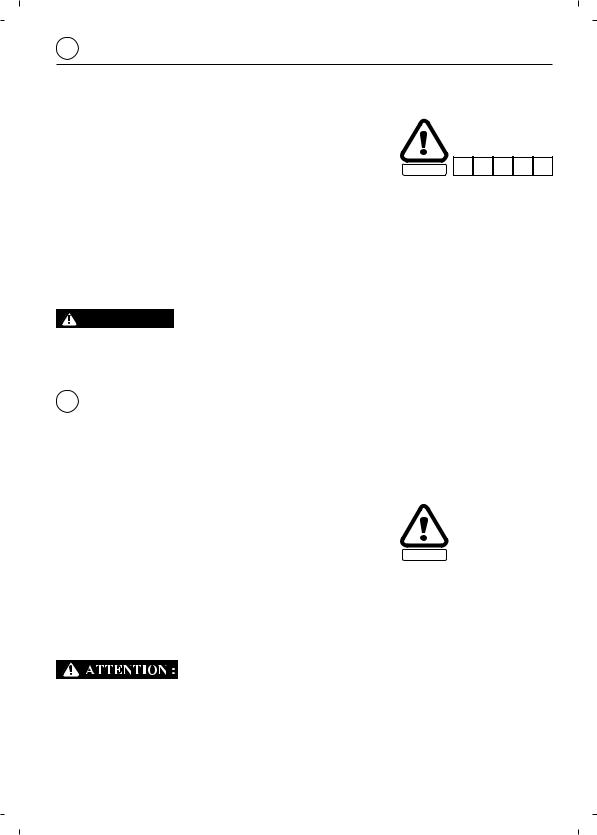
GB |
PREPARATIONS AND CHECKS BEFORE USE |
|
CHECKING BLADE CONDITION
CAUTION:
•Do not tilt the mower with the carburetor facing down; this will make the mower difficult to start later, due to engine oil contaminating the air cleaner.
To check blade condition: |
|
|
1. Stop the engine. |
SAFETY |
B3 B5 C18 D1 D8 |
2.Pull off the spark plug cap.
3.Place the mower on its side so that the carburettor is facing upwards (left side): Check if the blade shows signs of wear and replace it if necessary.
Check that blade bolts are tight (see Maintenance chapter).
To replace or remove the blade, refer to the procedure described in the Maintenance chapter.
[1]NEW BLADE
[2]WORN BLADE
WARNING :
Never operate the mower with a worn, damaged, split or dented blade. A piece of blade which breaks off and is thrown outwards can cause serious bodily injuries.
NOTE: Blade wear is increased when the mower is used on sandy soils. Inspect the blade more often when the mower is used in these conditions.
F |
PRÉPARATIONS ET VÉRIFICATIONS AVANT UTILISATION |
|
|
VÉRIFICATION DE L’ÉTAT DE LA LAME |
|
PRÉCAUTION :
•Ne pas incliner la tondeuse avec le carburateur orienté vers le bas ; il en résulterait un redémarrage très difficile par la suite, dû à l’obstruction du filtre à air par de l’huile moteur.
Pour vérifier l’état de la lame : |
|
|
|
|
|
|
||
1. |
Arrêter le moteur. |
|
|
|
|
|
|
|
2. |
Retirer le capuchon de la bougie d’allumage. |
|
|
|
|
|
|
|
3. |
Mettre la tondeuse sur le côté droit, de telle sorte que |
|
|
|
|
|
|
|
SECURITE |
B3 |
B5 |
C18 |
D1 |
D8 |
|||
|
le carburateur soit orienté vers le haut. |
|||||||
|
|
|
|
|
|
|||
|
|
|
|
|
|
|
||
|
Vérifier si la lame présente des signes d’usure et la remplacer, si c’est nécessaire. |
|
|
|||||
Vérifier le serrage des vis de lame (voir chapitre Entretien).
Pour remplacer la lame ou effectuer une dépose-repose, se référer à la procédure décrite au chapitre Entretien.
[1]LAME NEUVE
[2]LAME USAGEE
Ne jamais faire fonctionner la tondeuse avec une lame usée ou endommagée, fendue ou entaillée.
Un morceau de lame qui se casse et se trouve projeté peut être la cause de blessures graves.
NOTE :L’usure de la lame est plus rapide, lorsque la tondeuse travaille sur des sols sablonneux. Examiner très souvent la lame, en cas d’utilisation de la tondeuse dans ces conditions.
23
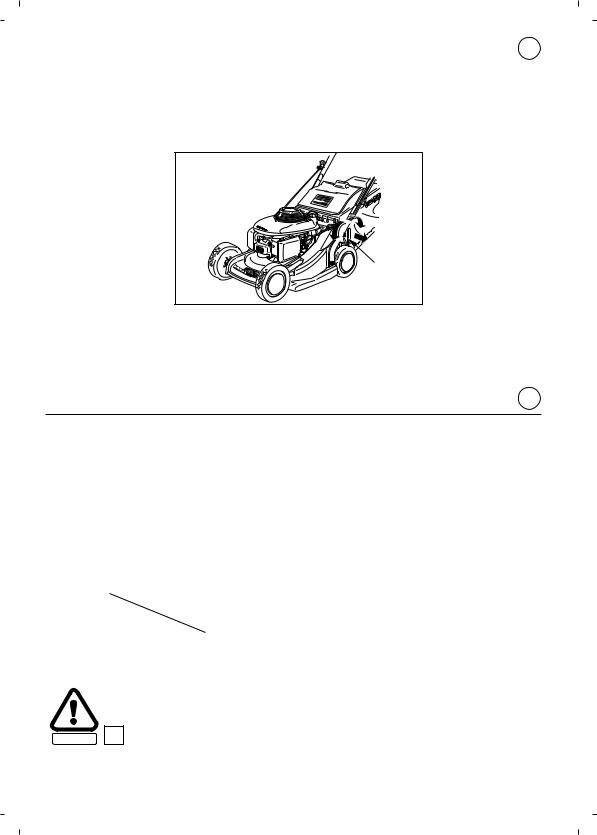
VORBEITUNGEN UND KONTROLLEN VOR INBETRIEBNAHME |
D |
|
[1]
D
SCHNITTHÖHENEINSTELLUNG
Veränderung der Schnitthöhe:
1.Motor stoppen.
2.Ziehen Sie den Einstellhebel [1] heraus.
3.Schieben Sie den Einstellhebel [1] nun nach vorne bzw. nach hinten in Verbindung mit Anheben oder Absenken der Räder, um die optimale Einstellhöhe zu erreichen.
Die Höhenangaben sind Anhaltswerte. Die tatsächliche Schnitthöhe wird am besten durch einen Mähversuch ermittelt, da sie von der Bodenbeschaffenheit und dem Rasen abhängt.
Schnitthöhe (in mm)
Stellung |
1 |
2 |
3 |
4 |
5 |
6 |
|
||||||
Schnitthöhe |
|
|
|
|
|
|
mm (Typen Q) |
14 |
24 |
33 |
43 |
53 |
|
mm (Andere) |
18 |
28 |
40 |
50 |
62 |
75 |
SICHERHEIT C20
24
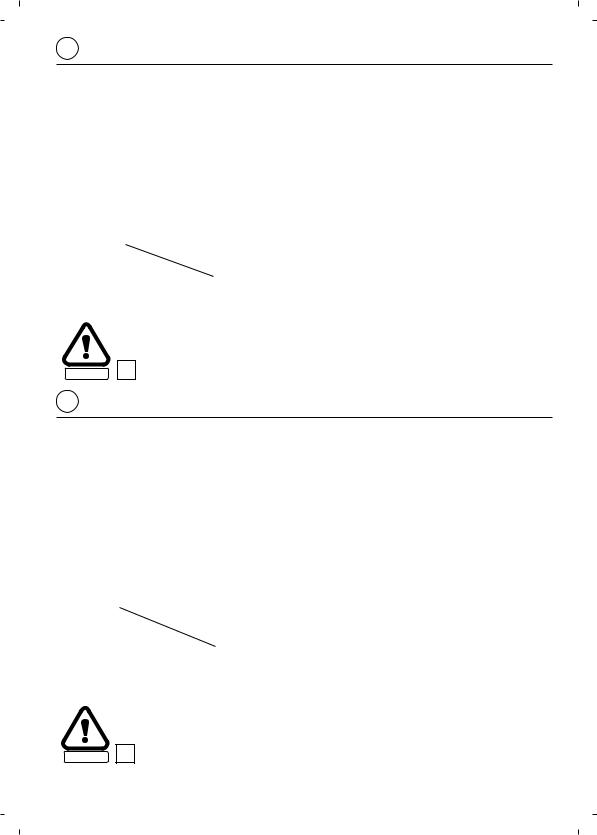
GB |
PREPARATIONS AND CHECKS BEFORE USE |
|
ADJUSTING CUTTING HEIGHT
To change the cutting height:
1.Stop the engine.
2.Pull the adjusting lever [1] towards the outside of the machine.
3.Turn the adjusting lever [1] left or right to move the wheels up or down to raise or lower the cutting height.
The cutting height settings are approximate values, the actual height of the cut grass varies with the lawn and ground condition. To choose the cutting height, check how the lawn looks after mowing a small area and adjust the cutting height where necessary.
Cutting heights (mm)
Position |
1 |
2 |
3 |
4 |
5 |
6 |
|
Height |
|||||||
|
|
|
|
|
|
||
mm (Q types) |
14 |
24 |
33 |
43 |
53 |
|
|
mm (others) |
18 |
28 |
40 |
50 |
62 |
75 |
|
|
|
|
|
|
|
|
SAFETY |
C20 |
F |
PRÉPARATIONS ET VÉRIFICATIONS AVANT UTILISATION |
|
RÉGLAGE DE LA HAUTEUR DE COUPE
Pour changer la hauteur de coupe :
1.Arrêter le moteur.
2.Tirer le levier d’ajustement [1] vers l’extérieur de la machine.
3.Tourner le levier d’ajustement [1] vers la droite ou la gauche pour augmenter ou diminuer la hauteur de coupe.
Les réglages de hauteur de coupe correspondent à des valeurs approximatives, la hauteur réelle de l’herbe coupée varie avec l’état de la pelouse et du sol. Pour choisir la hauteur de coupe, vérifier l’aspect de la pelouse après avoir tondu une petite surface et, le cas échéant, régler la hauteur de coupe.
Hauteur de coupe (mm)
Position |
1 |
2 |
3 |
4 |
5 |
6 |
|
Hauteur |
|||||||
|
|
|
|
|
|
||
|
|
|
|
|
|
|
|
mm (type Q) |
14 |
24 |
33 |
43 |
53 |
|
|
mm (autres) |
18 |
28 |
40 |
50 |
62 |
75 |
|
|
|
|
|
|
|
|
SECURITE C20
25
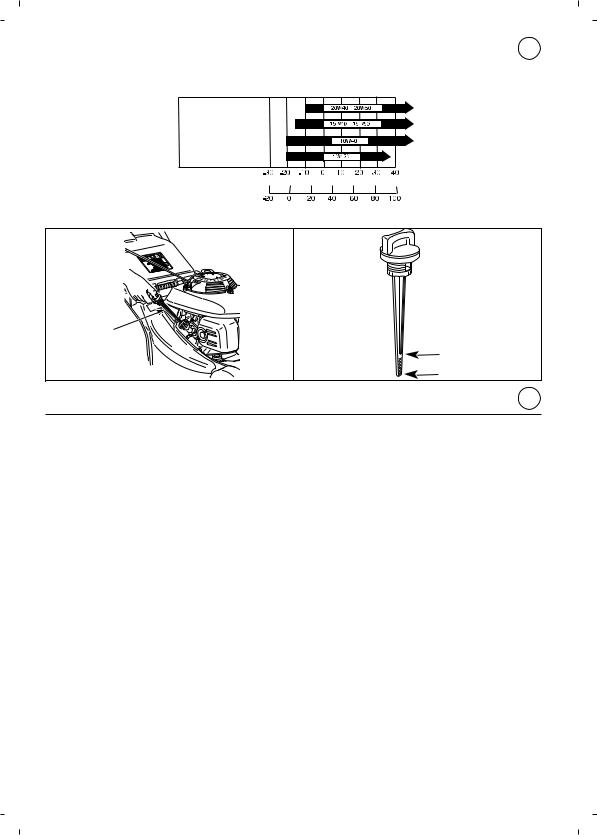
VORBEITUNGEN UND KONTROLLEN VOR INBETRIEBNAHME |
D |
|
[1] |
[2] |
[3] |
[5] |
[4] |
D |
ÖLSTANDKONTROLLE |
VORSICHT: |
•Das Motoröl beeinflußt die Leistung und Lebensdauer ihres Gerätes !
•Niemals den Motor ohne oder mit zu wenig Öl laufen lassen, dies verursacht schwere Schäden am Motor. Verwenden Sie Original Honda Motoröl oder Markenöle für 4-Takt- Motoren mit SAE-Viskosität 10W30. Den optimalen Viskositätsgrad finden Sie je nach Lufttemperatur und Höhenlage des Rasengeländes aus vorheriger Tabelle.
[1]MEHRBEREICHSÖL
[2]UMBEDUNGSTEMPERATUR Kontrolle des Ölstands:
1.Rasenmäher mit allen Rädern auf exakt horizontalen Boden stellen.
2.Öltankverschluß durch Linksdrehung abschrauben, herausziehen [3] und abwischen.
3.Meßstab wieder bis zum Anschlag in den Einfüllstutzen stecken, nicht zuschrauben.
4.Meßstab herausziehen und in waagrechter Stellung den Ölstand ablesen. Der Ölstand muß sich zwischen Minimum- [4] und Maximum-Marke [5] befinden. Vor Erreichen der MinimumMarke Öl nachfüllen (siehe auch Wartungshinweise). Kontrolle durch Wiederholung von 3. und 4. Nicht überfüllen!
5.Meßstab wieder in Einfüllstutzen stecken und mit Rechtsdrehung zuschrauben.
26
